The beginning period of English Literature
英美文学复习资料
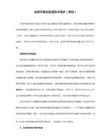
2). What is the contribution of Geoffrey Chaucer to English literature?
Chapter1. The Renaissance Period
一.重点
前言部分
4). In The Canterbury Tales, ______ presented to us a comprehensive realistic picture of the English society of his time and created a whole gallery of vivid characters from all walks of life.
A. spiritual----hero B. natural----leader C. spiritual----god D. natural----monster
二. 《英美文学选读》的考核目标,按照识记,领会,应用规定应当达到的能力层次要求。三个层次呈递进关系,其含义是:
识记: 有关的概念、定义、知识点等能够记住
领会: 在识记的基础上,能够把握基本概念、基本方法和彼此之间的关系和区别
应用了在领会的基础上,能运用本课程的基本理论,基本知识和方法来分析英美文学作品,并能用英语正确表达。
1. 文艺复兴的起源,起始时间,内容及特征
2. 人文主义的有关主张及对文学的影响
3. 文艺复兴时期的主要文学形式及其特征
练习:
Renaissance Period
1. Choose the best answer for each blank.
1). The Renaissance, in essence, is a historical period in which the European ______ thinkers and scholars made attempts to get rid of those old feudalist ideas in medieval Europe, to introduce new ideas that expressed the interests of the rising bourgeoisie, and to recover the purity of the early church form the corruption of the Roman Catholic Church.
the history of English language英语语言发展历史

The industrial revolution
History of the English Language
•
The history of the English language really started with the arrival of three Germanic tribes who invaded Britain during the 5th century AD. These tribes, the Angles, the Saxons and the Jutes, crossed the North Sea from what today is Denmark and northern Germany. At that time the inhabitants of Britain spoke a Celtic language. But most of the Celtic speakers were pushed west and north by the invaders - mainly into what is now Wales, Scotland and Ireland. The Angles came from Englaland and their language was called Englisc - from which the words England and English are derived. • 英语真正的历史应该从公元5世纪时入侵英国的三个日耳曼部 落说起. 这几个部落分别是, 盎格鲁人, 撒克逊人,和朱特人,他 们从今天的德国北部和丹麦出发,然后横渡北海。那时候英国 的本地居民都说凯尔特语。但由于入侵者的逼迫,他们都被赶 到了西部和北部-主要是现在的威尔士,苏格兰和爱尔兰。盎格 鲁人来自 Englaland 他们的语言称为 Englisc (古英语) - 这两个 词就是现在England和English的前身。
【优质】英国文学简史小题

28.P72 P76
29.Othello is a new man of the Renaissance. Othello is a tragedy of humanism. Othello is also a tragedy of the coloured people in a society of racial prejudice.
9.The Prologue provides a framework for the tales. Chaucer has been called“the founder of English realism.”
10.The first complete English Bible was translated by John Wycliffe.(1324-1384) Authorized Version, which was King James Bible.
15.Spenser: the Poet’s Poet The Shepherd’s Calendar, a pastoral poem in twelve books, one for each month of the year.
16.Spenser’s greatest work, The Faerie Queene is along poem planned in 12 books, of which he finished only 6. The work was dedicated to Queen Elizabeth. It is an allegory.
文学知识
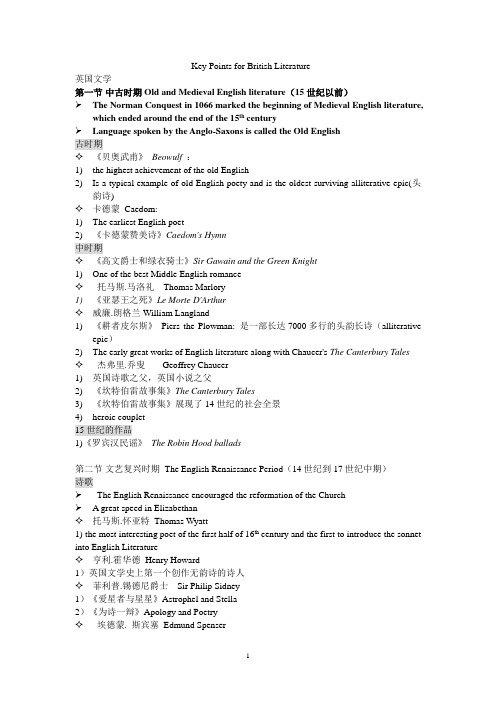
Key Points for British Literature英国文学第一节中古时期Old and Medieval English literature(15世纪以前)The Norman Conquest in 1066 marked the beginning of Medieval English literature, which ended around the end of the 15th centuryLanguage spoken by the Anglo-Saxons is called the Old English古时期✧《贝奥武甫》Beowulf :1)the highest achievement of the old English2)Is a typical example of old English poety and is the oldest surviving alliterative epic(头韵诗)✧卡德蒙Caedom:1)The earliest English poet2)《卡德蒙赞美诗》Caedom's Hymn中时期✧《高文爵士和绿衣骑士》Sir Gawain and the Green Knight1)One of the best Middle English romance✧托马斯.马洛礼Thomas Marlory1)《亚瑟王之死》Le Morte D'Arthur✧威廉.朗格兰William Langland1)《耕者皮尔斯》Piers the Plowman: 是一部长达7000多行的头韵长诗(alliterativeepic)2)The early great works of English literature along with Chaucer's The Canterbury Tales✧杰弗里.乔叟Geoffrey Chaucer1)英国诗歌之父,英国小说之父2)《坎特伯雷故事集》The Canterbury Tales3)《坎特伯雷故事集》展现了14世纪的社会全景4)heroic couplet15世纪的作品1)《罗宾汉民谣》The Robin Hood ballads第二节文艺复兴时期The English Renaissance Period(14世纪到17世纪中期)诗歌The English Renaissance encouraged the reformation of the ChurchA great speed in Elizabethan✧托马斯.怀亚特Thomas Wyatt1)the most interesting poet of the first half of 16th century and the first to introduce the sonnet into English Literature✧亨利.霍华德Henry Howard1)英国文学史上第一个创作无韵诗的诗人✧菲利普.锡德尼爵士Sir Philip Sidney1)《爱星者与星星》Astrophel and Stella2)《为诗一辩》Apology and Poetry✧埃德蒙. 斯宾塞Edmund Spenser1)诗人中的诗人the poets poet2)桂冠诗人poet laureate3)斯宾塞是伊莉莎白时期最伟大的非戏剧诗人,被称为诗圣4)《牧羊人日记》The Shepherd's Calendar5)《新婚喜歌》Epithalamion6)《仙后》Faerie Queene:斯宾塞诗体,亚历山大格式散文✧托马斯.莫尔Thomas More1)《乌托邦》Utopia✧弗朗西斯.培根Francis Bacon1)第一位英国散文家2)《亨利七世的统治和生活史》3)《论学术的进展》The Advancement of Learing4)《论说文集》Eassys5)《新亚特兰蒂斯》The New Atlantis✧约翰.黎里John Lyly1) 《尤弗西斯》Euphues:euphuism(跨市文体)戏剧✧克里斯托弗.马洛Christopher Malowe1)莎士比亚前最伟大的剧作家,是大学才子派(University Wits)中最有天赋的作家,首创戏剧的创作手法“无韵诗”2)《帖木儿》Tamburlaine3)《浮士的博士的悲剧》4)《马耳他岛的犹太人》The Jew of Malta✧莎士比亚1)英国文艺复兴时期最重要的剧作家2)喜剧:A Midsummer Night’s Dream; The Merchant of V enice; As You Like It; The Twelfth Night《十二夜》,Much Alo About Nothing《无事生非》3)悲剧: Hamlet; Othello; King Lear; Macbeth《罗密欧与朱丽叶》4)历史剧:《亨利四世》《亨利五世》5)长诗:《维纳斯和阿多尼斯》Venus and Adonis《露易丝受辱记》The Rape of Lucrece✧本. 琼森Ben Johnson1)《狐狸》V olpone2)The most important dramatist successors of Shakespeare第三节资产阶级革命和王政复辟时期The Period of Revolution and Restoration (17 世纪)资产阶级时期的诗人✧约翰.弥尔顿John Milton1)无韵诗大师2)他在这一时期的地位相当于莎士比亚在伊莉莎白时期,乔叟在中世纪时期的地位3)《失乐园》Paradise Lost : 本书是自《贝奥武甫》以后最伟大的英国史诗4)《复乐园》Paradise Regained5)《力士参孙》Samson Agonistes: the most perfect example of the verse drama after the Greek style in English✧约翰.多恩John Donne1)玄学派的创始人the founder of the Metaphysical School2)《日出》The Sun Rising3)《歌谣与十四行诗》Songs and Sonnets4)《神圣十四行诗》Holy Sonnets5)《给圣父的赞美诗》A Hymn to God the Father6)《死神莫骄妄》Death, Be Not Proud7)《分别:莫忧伤》A Valediction: Forbidding Mourning✧乔治.赫伯特George Herbert1)玄学派的圣人the saint of the Metaphysical School2)《祭坛》The Altar: 在这部作品中,作者用排版的技巧来表达他对宗教的虔诚3)《复活节的翅膀》Easter Wings资产阶级革命时期的散文家✧约翰.班扬1)清教徒清教徒时期地位最高的散文家,散文风格模仿《圣经》2)《天路历程》The Pilgrim's Progress:the most successful religious allegory(寓言)3)《落在愤怒之神手中的罪人》Grace Abounding to the Chief of Sinners4)《贝德曼先生》The Life and Death of Mr.Badman5)《圣战》The Holy War王政复辟时期的作家✧杰里米.柯里尔Jeremy Collier1)a non-conformist clergyman(非国传教士)2)《略论英国舞台上的不道德和亵渎》A Short View of the Immorality and Profaneness of the English Stage✧约翰.德莱顿John Dryden1)王朝复辟时期最著名的作家2)18世纪英国古典主义的先驱者the forerunner of the English classical school of literature3)是弥尔顿时期与蒲柏时期之间最伟大的诗人,称桂冠诗人达20年4)他把英雄双韵体作为讽刺诗和描述性诗体的风尚5)英国批评文学之父the father of English criticism6)《?鹿与豹》The Hind and the Panther7)《一切为了爱情》All for Love8)《押沙龙与阿托奈托菲尔》Absalom and Achitophel: subject is politics and is written in heroic couplet9)《论戏剧诗歌》An Essay of Dramatic Poesy: his best work第四节启蒙运动The Age of Enlightenment(18世纪)The 18th century of England is known as the Age of Enlightenment or the Age of Reason(理性时期)Neo-Classicism(新古典主义) made a rapid growth in the 18th centuryThe rise and growth of the realistic novel is the most important achievement in the 18th century English literayure新古典主义作家✧亚历山大.浦柏Alexander Pope1) 浦柏是英国18世纪最伟大的诗人,以讽刺诗体以及对《荷马史诗》的翻译而闻名2)首次把理性主义带到英国3)《论批评》An Essay on Criticism4) 《夺发记》The Rape of the Lock: 优秀的讽刺史诗a finest mockepic5) 《人伦》Essay on Man: a philosophical poem in heroic couplets✧理查德.斯梯尔Richard Steele 约瑟夫.艾迪生Joseph Addison《闲谈者报》和《旁观者报》The Tattler and The Spectator are the literary periodicals by Richard Steele and Joseph Addison✧塞缪尔.约翰逊Samuel Johnson1)《英语字典》:become the foundation of all the subsequent English dictionaries 2)《诗人转》The Lives of English Poet现实主义作家✧丹尼尔.笛福Daniel Defoe1)是现代小说的奠基人2)英国和欧洲小说之父3)《鲁宾逊漂流记》Robinson Crusoe: the first English novel4)《辛格顿船长》Captain Singleton:narrator of his own story5)《杰克上校》Colonel Singleton6)《摩尔•弗兰德斯》Moll Flanders: autobiography✧乔纳森.斯威夫特1)An Irish master of Satires2)《一个木桶的故事》A Tale of a Tub: a parable(寓言),established his name as asatirist3)《一个麻布商的书信》The Drapper's Letters4)《一个谦卑的建议》A Modest Proposal: the author denounces the cruel and unjusttreatment of Ireland by the English government and stir up the Irish people to fight5)《对1708的预言》Predictions for the Year 17086)《比克斯塔夫先生第一个预言的应验》Vindication of Isaac Bickerstaff7)《格列弗游记》Gulliver’s Travels:本书是对英国和欧洲生活各个方面最有效的,最具破坏性的批评和讽刺✧亨利.菲尔丁Henry Fielding1)Father of the English NovelAs a novelist:2)《约瑟夫.安德鲁斯的经历》:in the preface, he decribes the novel" a comic epic poemin prose''(散文滑稽史诗)3)《大伟人乔纳森.魏尔德》Jonathan Wild the Great: exposes the English bourgeoissociety(资产阶级社会)and mocks at its political system4)《弃婴汤姆.琼斯的故事》The History of Tom Jones, a Foyndling:以人性为主题,作者认为人性是善与恶的结合5)《阿米丽亚》Amelia: reveal the shameless deed of the noble and the rich感伤主义作家Writers of Sentimental Tradition✧塞缪尔.查理森Samuel Richardson1)《帕米拉》Pamela, or Virtue Rewarded2)《克拉丽萨》Clarissa Harlowe3)《查尔斯.格兰迪森爵士》Sir Richard Grandison✧劳伦斯.斯特恩Laurence Sterne1)《项狄传》Tristram Shandy2)《伤感旅行》A Sentimental Journey✧奥利弗.戈德史密斯Oliver Goldsmith1)他是感伤主义学派的杰出代表2)《旅游人》The Traveler3)《荒村》The Deserted Village: his best poem4)《威克菲尔德牧师》The Vicar of Wakefield: provide one of the most enduringcharacters in English fiction✧托马斯.格雷Thomas Gray1)他是感伤主义诗歌,墓畔派的领导人。
英国文学史选读复习资料
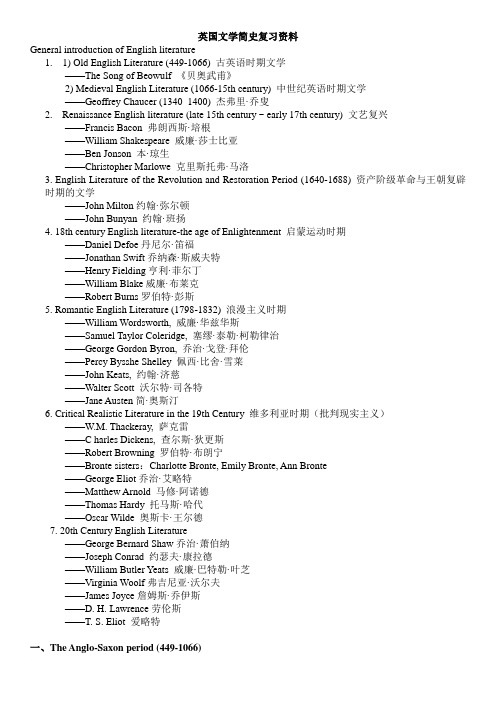
英国文学简史复习资料General introduction of English literature1. 1) Old English Literature (449-1066) 古英语时期文学——The Song of Beowulf 《贝奥武甫》2) Medieval English Literature (1066-15th century) 中世纪英语时期文学——Geoffrey Chaucer (1340_1400) 杰弗里·乔叟2. Renaissance English literature (late 15th century ~ early 17th century) 文艺复兴——Francis Bacon 弗朗西斯·培根——William Shakespeare 威廉·莎士比亚——Ben Jonson 本·琼生——Christopher Marlowe 克里斯托弗·马洛3. English Literature of the Revolution and Restoration Period (1640-1688) 资产阶级革命与王朝复辟时期的文学——John Milton约翰·弥尔顿——John Bunyan 约翰·班扬4. 18th century English literature-the age of Enlightenment 启蒙运动时期——Daniel Defoe丹尼尔·笛福——Jonathan Swift乔纳森·斯威夫特——Henry Fielding亨利·菲尔丁——William Blake威廉·布莱克——Robert Burns罗伯特·彭斯5. Romantic English Literature (1798-1832) 浪漫主义时期——William Wordsworth, 威廉·华兹华斯——Samuel Taylor Coleridge, 塞缪·泰勒·柯勒律治——George Gordon Byron, 乔治·戈登·拜伦——Percy Bysshe Shelley 佩西·比舍·雪莱——John Keats, 约翰·济慈——Walter Scott 沃尔特·司各特——Jane Austen简·奥斯汀6. Critical Realistic Literature in the 19th Century 维多利亚时期(批判现实主义)——W.M. Thackeray, 萨克雷——C harles Dickens, 查尔斯·狄更斯——Robert Browning 罗伯特·布朗宁——Bronte sisters:Charlotte Bronte, Emily Bronte, Ann Bronte——George Eliot乔治·艾略特——Matthew Arnold 马修·阿诺德——Thomas Hardy 托马斯·哈代——Oscar Wilde 奥斯卡·王尔德7. 20th Century English Literature——George Bernard Shaw乔治·萧伯纳——Joseph Conrad 约瑟夫·康拉德——William Butler Yeats 威廉·巴特勒·叶芝——Virginia Woolf弗吉尼亚·沃尔夫——James Joyce詹姆斯·乔伊斯——D. H. Lawrence劳伦斯——T. S. Eliot 爱略特一、The Anglo-Saxon period (449-1066)1、这个时期的文学作品分类:pagan(异教徒) ,Christian(基督徒)2、代表作:The Song of Beowulf《贝奥武甫》( national epic 民族史诗) 采用了隐喻metaphor手法3、Alliteration 头韵(写作手法)例子:of m an was the m ildest and m ost beloved,To his k in the k indest, k eenest for praise.二、The Anglo-Norman period (1066-1350) 盎格鲁—诺曼时期1、romance 传奇文学2、代表作:Sir Gawain and the Green Knight (高文爵士和绿衣骑士) 是一首押头韵的长诗三、Geoffrey Chaucer (1340-1400) 杰弗里·乔叟时期1、the father of English poetry 英国诗歌之父2、heroic couplet 英雄双韵体:a verse unit consisting of two rhymed(押韵) lines in iambic pentameter(五步抑扬格)3、代表作:The Canterbury Tales 《坎特伯雷的故事集》(英国文学史的开端)大致内容:the pilgrims are people from various parts of England, representatives of various walks of life and social groups. 朝圣者都是来自英国的各地的人,代表着社会的各个不同阶层和社会团体小说特点:each of the narrators tells his tale in a peculiar manner, thus revealing his own views and character. 这些叙述者以自己特色的方式讲述自己的故事,无形中表明了各自的观点,展示了各自的性格。
英语的发展史(中英文版)
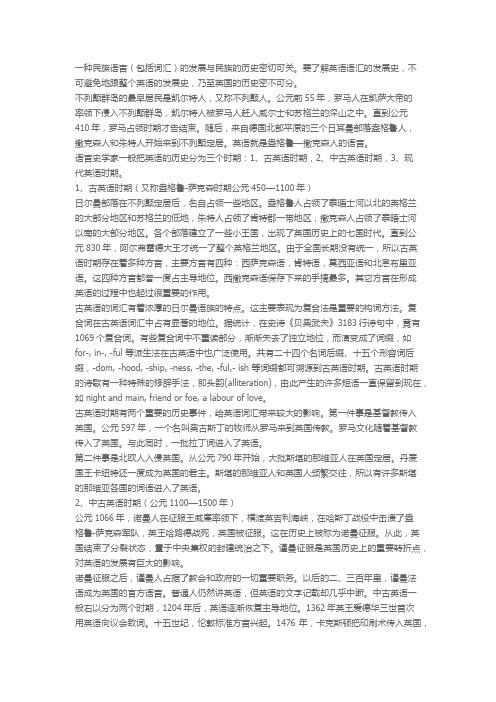
一种民族语言(包括词汇)的发展与民族的历史密切可关。
要了解英语语汇的发展史,不可避免地跟整个英语的发展史,乃至英国的历史密不可分。
不列颠群岛的最早居民是凯尔特人,又称不列颠人。
公元前55年,罗马人在凯萨大帝的率领下侵入不列颠群岛,凯尔特人被罗马人赶入威尔士和苏格兰的深山之中。
直到公元410年,罗马占领时期才告结束。
随后,来自德国北部平原的三个日耳曼部落盎格鲁人,撒克森人和朱特人开始来到不列颠定居。
英语就是盎格鲁—撒克森人的语言。
语言史学家一般把英语的历史分为三个时期:1、古英语时期,2、中古英语时期,3、现代英语时期。
1、古英语时期(又称盎格鲁-萨克森时期公元450—1100年)日尔曼部落在不列颠定居后,名自占领一些地区。
盎格鲁人占领了泰晤士河以北的英格兰的大部分地区和苏格兰的低地,朱特人占领了肯特郡一带地区,撒克森人占领了泰晤士河以南的大部分地区。
各个部落建立了一些小王国,出现了英国历史上的七国时代。
直到公元830年,阿尔弗雷德大王才统一了整个英格兰地区。
由于全国长期没有统一,所以古英语时期存在着多种方言,主要方言有四种:西萨克森语,肯特语,莫西亚语和北恩布里亚语。
这四种方言都曾一度占主导地位。
西撒克森语保存下来的手搞最多。
其它方言在形成英语的过程中也起过很重要的作用。
古英语的词汇有着浓厚的日尔曼语族的特点。
这主要表现为复合法是重要的构词方法。
复合词在古英语词汇中占有显著的地位。
据统计,在史诗《贝奥武夫》3183行诗句中,竟有1069个复合词。
有些复合词中不重读部分,渐渐失去了独立地位,而演变成了词缀,如for-, in-, -ful 等派生法在古英语中也广泛使用。
共有二十四个名词后缀、十五个形容词后缀,-dom, -hood, -ship, -ness, -the, -ful,- ish 等词缀都可溯源到古英语时期。
古英语时期的诗歌有一种特殊的修辞手法,即头韵(alliteration),由此产生的许多短语一直保留到现在,如night and main, friend or foe, a labour of love。
英语八级英美文学整理
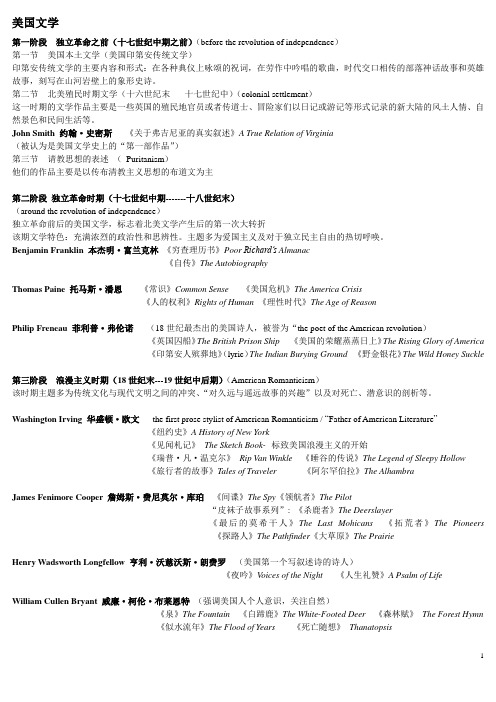
美国文学第一阶段独立革命之前(十七世纪中期之前)(before the revolution of independence)第一节美国本土文学(美国印第安传统文学)印第安传统文学的主要内容和形式:在各种典仪上咏颂的祝词,在劳作中吟唱的歌曲,时代交口相传的部落神话故事和英雄故事,刻写在山河岩壁上的象形史诗。
第二节北美殖民时期文学(十六世纪末-----十七世纪中)(colonial settlement)这一时期的文学作品主要是一些英国的殖民地官员或者传道士、冒险家们以日记或游记等形式记录的新大陆的风土人情、自然景色和民间生活等。
John Smith 约翰·史密斯《关于弗吉尼亚的真实叙述》A True Relation of Virginia(被认为是美国文学史上的“第一部作品”)第三节请教思想的表述(Puritanism)他们的作品主要是以传布清教主义思想的布道文为主第二阶段独立革命时期(十七世纪中期-------十八世纪末)(around the revolution of independence)独立革命前后的美国文学,标志着北美文学产生后的第一次大转折该期文学特色:充满浓烈的政治性和思辨性。
主题多为爱国主义及对于独立民主自由的热切呼唤。
Benjamin Franklin 本杰明·富兰克林《穷查理历书》Poor Richard’s Almanac《自传》The AutobiographyThomas Paine 托马斯·潘恩《常识》Common Sense 《美国危机》The America Crisis《人的权利》Rights of Human《理性时代》The Age of ReasonPhilip Freneau 菲利普·弗伦诺(18世纪最杰出的美国诗人,被誉为“the poet of the American revolution)《英国囚船》The British Prison Ship 《美国的荣耀蒸蒸日上》The Rising Glory of America《印第安人殡葬地》(lyric)The Indian Burying Ground 《野金银花》The Wild Honey Suckle第三阶段浪漫主义时期(18世纪末---19世纪中后期)(American Romanticism)该时期主题多为传统文化与现代文明之间的冲突、“对久远与遥远故事的兴趣”以及对死亡、潜意识的剖析等。
专业英语8级人文知识之美国文学

专业英语八级人文知识之美国文学第一阶段独立革命之前(十七世纪中期之前)概述1、美国本土文学(美国印第安传统文学)早在欧洲人闯入北美大陆之前,那里世世代代居住的原始人是印第安人,他们的文化早已在这片土地上流传、存在了几千年之久。
他们创造出了并仍然在创造这优秀的印第安口头文学。
在各种典礼上咏诵的祝词,在劳作中吟唱的歌曲,世世代代交口相传的部落神话故事和英雄故事,刻写在山间岩壁上的象形史诗,都是印第安传统文学的只要内容和形式,也是人类文明的宝贵遗产之一。
后来,随着殖民地的开拓,移民人数的剧增,印第安文化不断遭受重创,从而在17世纪出现断裂。
18世界末又开始以书面文学的形式开始了新的发展。
Three stages of development:1)traditional literature 2)transitional literature 3)modern literature2、北美殖民时期文学(十六世纪末—十七世纪中期)北美殖民文学的开端,以1607年英国在今佛吉尼亚的詹姆斯顿建立第一个永久性殖民点为标志。
从那时起直到1776年美利坚合众国成立,这半个世纪的北美英语文学的发展是外来文学移植、扎根并本土化的一个准备过程。
这一时期的文学作品主要是一些英国的殖民地官员或传道士、冒险家们以日记或游记随笔等形式记录的新大陆的风土人情、自然景色和民间生活等。
John Smith was considered to be the first author in the history of American literature。
3、清教思想的表述最初从欧洲来到美国的定居者被成为“清教徒”,因为他们迁徙的主要目的之一是为了“净化”教堂中的宗教行为。
他们的作品主要以传布清教主义思想的布道文为主。
第二阶段独立革命时期(17世纪中期—18世纪末)概述独立革命前后的美国文学,标志着北美文学产生后的第一次大转折,其主要内容和形式与殖民时期文学截然不同:如果说殖民时期文学主要反映的是清教精神,独立革命时期的文学则充满了浓烈的政治性和思辨性。
英国文学上
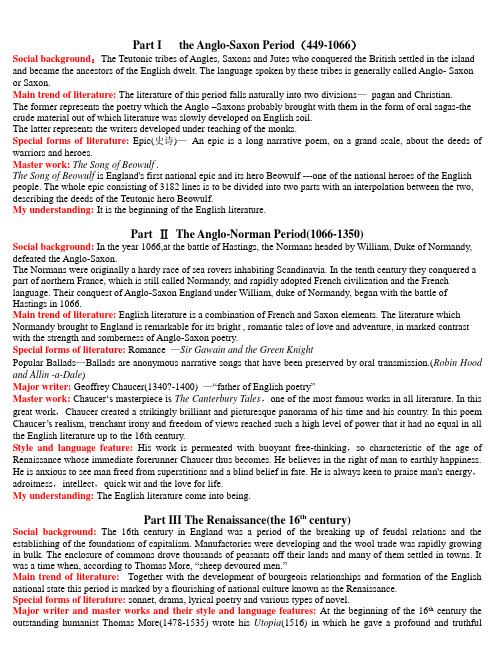
Part I the Anglo-Saxon Period(449-1066)Social background:The Teutonic tribes of Angles, Saxons and Jutes who conquered the British settled in the island and became the ancestors of the English dwelt. The language spoken by these tribes is generally called Anglo- Saxon or Saxon.Main trend of literature: The literature of this period falls naturally into two divisions—pagan and Christian.The former represents the poetry which the Anglo –Saxons probably brought with them in the form of oral sagas-the crude material out of which literature was slowly developed on English soil.The latter represents the writers developed under teaching of the monks.Special forms of literature:Epic(史诗)—An epic is a long narrative poem, on a grand scale, about the deeds of warriors and heroes.Master work:The Song of Beowulf .The Song of Beowulf is England's first national epic and its hero Beowulf ---one of the national heroes of the English people. The whole epic consisting of 3182 lines is to be divided into two parts with an interpolation between the two, describing the deeds of the Teutonic hero Beowulf.My understanding:It is the beginning of the English literature.Part ⅡThe Anglo-Norman Period(1066-1350)Social background:In the year 1066,at the battle of Hastings, the Normans headed by William, Duke of Normandy, defeated the Anglo-Saxon.The Normans were originally a hardy race of sea rovers inhabiting Scandinavia. In the tenth century they conquered a part of northern France, which is still called Normandy, and rapidly adopted French civilization and the French language. Their conquest of Anglo-Saxon England under William, duke of Normandy, began with the battle of Hastings in 1066.Main trend of literature: English literature is a combination of French and Saxon elements. The literature which Normandy brought to England is remarkable for its bright , romantic tales of love and adventure, in marked contrast with the strength and somberness of Anglo-Saxon poetry.Special forms of literature: Romance —Sir Gawain and the Green KnightPopular Ballads—Ballads are anonymous narrative songs that have been preserved by oral transmission.(Robin Hood and Allin -a-Dale)Major writer: Geoffrey Chaucer(1340?-1400) —―father of English poetry‖Master work:Chaucer‗s masterpiece is The Canterbury Tales,one of the most famous works in all literature. In this great work,Chaucer created a strikingly brilliant and picturesque panorama of his time and his country. In this poem Chaucer‘s realism, trenchant irony a nd freedom of views reached such a high level of power that it had no equal in all the English literature up to the 16th century.Style and language feature:His work is permeated with buoyant free-thinking,so characteristic of the age of Renaissance whose immediate forerunner Chaucer thus becomes. He believes in the right of man to earthly happiness. He is anxious to see man freed from superstitions and a blind belief in fate. He is always keen to praise man's energy,adroitness,intellect,quick wit and the love for life.My understanding:The English literature come into being.Part III The Renaissance(the 16th century)Social background: The 16th century in England was a period of the breaking up of feudal relations and the establishing of the foundations of capitalism. Manufactories were developing and the wool trade was rapidly growing in bulk. The enclosure of commons drove thousands of peasants off their lands and many of them settled in towns. It was a time when, according to Thomas More, ―sheep devoured men.‖Main trend of literature:Together with the development of bourgeois relationships and formation of the English national state this period is marked by a flourishing of national culture known as the Renaissance.Special forms of literature: sonnet, drama, lyrical poetry and various types of novel.Major writer and master works and their style and language features: At the beginning of the 16th century the outstanding humanist Thomas More(1478-1535) wrote his Utopia(1516)in which he gave a profound and truthful picture of the people's sufferings and put forward his ideal of a future happy society .In the first half of the 16th century there appeared lyrical poems by Thomas Wyatt (1503?-1542),Henry Howard, Earl of surrey(1517-1547) and others who initiated new poetical forms, borrowing freely from English popular songs and Italian and French poetry. Thus Wyatt was the first to introduce the sonnet into English literature.In the second half of the 16th century lyrical poetry became widespread in England. Among the outstanding lyrical and epic poets of the time were Philip Sidney (1554-1586), Thomas Campion (1567-1680), and Edmund Spenser (1552-1599). The latter was the author of the greatest epic poem of the time The Fairy Queen.John Lyly (1553?-1606) and Thomas Loge (1558?-1625) were authors of novels dealing with court life and gallantry. Realistic tendencies developed in Thomas Deloney‘s (1543-1607) and Thomas Nashe‘s (1567-1602) novels, devoted to the everyday life of craftsmen, merchants and other representatives of the lower classes.The greatest of the pioneers of English drama was Christopher Marlowe (1564-1593) who reformed that genre in England and perfected the language and verse of dramatic works. It was Marlowe who made blank verse the principal vehicle of expression in drama. Robert Greene(1560?-1592)was a outstanding dramatist whose play George Green, the Pinner of Wakefield was highly appreciated.The great English scientist and philosopher Francis Bacon (1561-1626) whose s famous Literary work is the Essays. Francis Bacon's works may be divided into three classes: the philosophical, the literary,and the professional works. The principal and best known of the philosophical works are: the Advncement of Learning,(学术的推进)publshed in English in 1605; the Novum Organum新工具,published in Latin in 1620; and the De Augmentis,published in Latin in 1623. Of Bacon's litera works,the most important are the Essays.T he greatest humanist writer of this period —William Shakespeare(1564-1616).William Shakespeare is the greatest of all English authors. He belongs to those rare geniuses of mankind who have become landmarks in the history of world culture. The works of William Shakespeare are a great landmark in the history of world literature for he was one of the first founders of realism,a master hand at realistic portrayal of human characters and relations.No wonder that Shakespeare's works were so fondly cherished by the greatest minds of mankind,and among them by Karl Marx,who regarded Aeschylus and Shakespeare as "the two greatest dramatic geniuses the world has ever known.‖ It is well known in what high esteem Shakespeare was held by such giants of world literature as Milton,Goethe,Stendhal,and Pushkin.Works of Shakespeare.During the twenty-two years of his literary work he produced 38 plays,2 narrative poems and 154 sonnets. His literary work may be divided into three major periods: the first period from 1590 to 1600,the second from 1601 to 1608,and the third from 1609 to 1612.The first period:1590 The Second Part of King Henry VThe Third Part of King Henry V1591 The First Part of King Henry V1592 The Life and Death of King Richard IIIThe Comedy of Errors《错误的喜剧》1593 Titus AndronicusThe Taming of the Shrew(驯悍记)1594 The Two Gentlemen of Verona(维洛那二绅士)Love's Labor‘s Lost(爱的徒劳)Romeo and Juliet(罗密欧与朱丽叶)1595 The Life and Death of Richαrd IIA Midsummer Night's Dream(仲夏夜之梦)1596 The Life and Death of King JohnThe Merchant of Venice(威尼斯商人)1597 The First Part of King Henry IVThe Second Part of King Henry IV1598 Much Ado About Nothing(无事烦恼)The Merry Wives of Windsor(温莎的风流娘儿们)The Life of King Henry V1599 The Life and Death of Julius CaesarAs You Like It(皆大欢喜)1600 Twelfth Night, or, What You Will(第十二夜)The second period:1601 Hamlet,Prince of Denmark (哈姆莱特)1602 Troilus and CressidaAll's Well That Ends Well. (终成眷属)1604 Measure for Measure(一报还一报)Othello,the Mooe of Venice(奥赛罗)1605 King Lear(李尔王)The Tragedy of Macbeth(麦克白)1606 Antony and Cleopatra1607 The Tragedy of CriolanusTimon of Athens1608 Pericles,Prince of TyreThe third period:1609 Cymbeline, King of Britain (辛白林)1610 The Winter's Tale(冬天的故事)1612 The Tempest(暴风雨)The Life of King Henry VIIIShakespeare had also written poems: Venus an Adonis(1592),Lucrece (1592-1593),and Sonnets (1593-1598). Among these works, Hamlet is considered to be the summit of Shakespeare‘s art. The whole tragedy is permeated with the spirit of Shakespeare‘s own time. Hamlet is the profoundest expression of Shakespeare's humanism and his criticism of contemporary life.My understanding: It is a flourishing time of English literature.Part IV The 17th Century :The period of revolution and restorationSocial background: The 17th century was one of the most tempestuous periods in English history. It was a period when absolute monarchy impeded the further development of capitalism in England and the bourgeoisie could no longer bear the sway of landed nobility. The contradictions between the feudal system and the bourgeoisie had reached its peak and resulted in a revolutionary outburst.Main trend of literature: In this period in literature also the Puritan Age was one of confusion,due to the breaking up of old ideals. The Puritans believed in simplicity of life. They disapproved of the sonnets and the love poetry written in the previous period. The Bible became now the one book of the people. The Puritan influence in general tended to suppress literary art.Special forms of literature:In this period in the absence of any fixed standard of literary criticism there was nothing to prevent the exaggeration of the "metaphysical" poets,who are the literary parallels to religious sects like the Anabaptists(浸礼教徒). Poetry took new and startling forms in Donne and Herbert,and prose became as somber as Burton's Anatomy of Melancholy.Major writer and master works and their style and language features:John Donne (1572?-1631) is a more thoroughly characteristic figure of the early seventeenth century. His religious poems and his magnificent sermons reached astounding heights of subtlety and intensity. The searchings of soul andthe horrified fascination with which he contemplated the processes of dissolution and the awful event of death are rendered with amazing intellectual ingenuity and imaginative power. His prose style, involuted and ornate, cumulative and Ciceronian, is one of the more glorious monuments to the spirit of the early seventeenth century.John Milton (1608-1774) is a great English poet. John Milton was the child of the Renassance, inherited all its culture, and the most profoundly educated man of his age. His greatest work Paradise Lost presents the author‘s views in an allegoric(比喻的,寓言的) religious form. The basic idea in this poem is: the exposure of reactionary forces of his time and passionate appeal for freedom. The poem is on the biblical legend of imaginary progenitors of the human race—Adam and Eve, and involves God and his eternal adversary, Satan. His another poem is Paradise Regained. John Bunyan (1628-1688) is a great prose writer. His most important work is The Pilgrim’s Progress, written in the old-fashioned, medieval form of allegory and dream.My understanding: It is a time of revolution and restoration.Part V The 18th Century:The Age of English Enlightenment in EnglandSocial background: After the tempestuous events of the 17th century, England entered a period of a comparatively peaceful development.Main trend of literature: With the advent of the 18th century,in England,as in other European countries,there sprang into life a public movement known as the Enlightenment(启蒙运动)The Enlightenment on the whole,was an expression of struggle of the then progressive class of bourgeoisie against feudalism. The enlighteners fought against class inequality,stagnation,prejudices and other survivals of feudalism. They attempted to place all branches of science at the service of mankind by connecting them with the actual deeds and requirements of the people.And the new literature current—that of Sentimentalism appeared. Sentimentalism in literature is ―emotion run wild,‖ with emphasis on feeling rather on events and circumstances which produced the feeling.Another conspicuous trend in the English literature of the later half of the 18th century was the so-called pre-romanticism. It originated among the conservative groups of men of letters as a reaction against Enlightenment and found its most manifest expression in the "Gothic novel",the term arising from the fact that the greater part of such romances were devoted to the medieval times.Special forms of literature: Neo-classicism (poetry and prose), realistic novel and the gothic novel.Major writer and master works and their style and language features:Enlighteners fell into two groups — the moderate group and the radical group. Moderate enlighteners supported the principles of the existing social order and considered that partial reforms would be sufficient. In this group may be included chiefly Alexander Pope(1688-1744), Joseph Addison(1672-1719) and Richard Steele(1672-1729), Daniel Defoe (1660-1731) and Samuel Richardson(1689-1761). They tried to work out a standard of moral conduct, which could be more suitable to the existing social conditions. Radical enlighteners struggled for more resolute democratization in the management of the government, and defended the interests of the exploited masses, the peasants and the working people in the cities. The representative writers of this group are Jonathan Swift(1667-1745), Henry Fielding(1707-1754), Tobias George Smollet(1721-1771), Oliver Goldsmith(1730-1774) and Richard Brinsley Sheridan(1751-1816). They stressed the discrepancy between what they called "the proper, moral standards"and the bourgeois-aristocratic society of their age.Alexander Pope (1688-1744)①An Essay on Criticism (1711)②The Rape of the Lock (1712-14)③Essay on Man (1733-34)④The Dunciad (1728)2. Joseph Addison (1672-1719) and Richard Steele (1672-1729)①The Tatler②The SpectatorDaniel Defoe (1660-1731)①Robinson Crusoe1719②Captain Singleton—a novel of adventure, 1720③Moll Flanders—written in the form of autobiography, 1722④Colonel Jacque—a novel of adventure, 1722三、Jonathan Swift (1667-1745) The Battle of the Books (1704), and A Tale of a Tub (1704). The former is a satirical dialogue on the comparative merits of ancient and modern writers. It mainly attacks on pedantry in literary world of the time. The latter is a prose satire written in the form of a parable and a sharp attack on the disputes among the different sects of the Christian religion.Among the pamphlets he wrote about Ireland, the best-known pieces are The Drapier' s Letters and A Modest Proposal Swift‘s tragic live affairs were recorded in his poem Cadenus and Vanessa and Journal to Stella. Before his death, Swift published a poem On the Death of Dr. Swift.Henry Fielding (1707-1754)①Joseph Andrews1742②Jonathan Wild the Great1743.③The History of Tom Jones, a Foundling 1749④Amelia 1751William Blake (1757-1827)①Songs of Innocence1789②Songs of Experience1794③The Marriage of Heaven and HellRobert Burns (1759-1796)Most of Burns‘s poems are lyrics on love and friendship. They have a great charm of simplicity. His best-known lyrics are A Red, Red Rose, and Auld Lang Syne.③Burns wrote some poems to express his hatred for the oppression of the ruling class and his love for freedom. A best-known poem of this kind is A Man's A Man for That.④Burns wrote some patriotic poems, in which he expresses his deep love for his motherland; such as My Heart's inthe Highlands.⑤Burns wrote some verse-tales which he based on old Scottish legends. In these poems, he sings of the heroic spirit of the Scottish people in their struggle against their oppressors. The best example of these poems is John Barleycorn.⑥Burns wrote a number of poems on the theme of revolution, such as The Tree of Liberty and A Revolutionary Lyric.⑦Burns also achieve success in the field of satire. E.g. The Toadeater.⑧Poems like The Jolly Beggars are characterized by humor and lightheartedness.Richard Brinsley Sheridan (1751-1816)①The Rivals②The School for ScandalFeaturesSheridan‘s dramatic techniques are largely conventional; th ey are exploited to the best advantage. His plots are well organized; his characters, either major or minor, all sharply drawn; and his manipulation of such devices as disguise, mistaken identity and dramatic irony is masterly. Witty dialogues and neat and decent language also make a characteristic of his plays.My understanding: The age of English Enlightenment in England。
英国文学史课程考试大纲

Part One Early and Medieval English LiteratureChapter 1 The Making of EnglandI.The Britons : a tribe of Celts, the early inhabitants in the Island, form which (Britons)Britain ( i.e. Land of Britons) got its name.(识记,重点)II.The Roman Conquest : In 55 B.C. Britain was invaded by Julius Caesar, the Roman conqueror. The Roman conquest lasted for about 400 years (to AD 410). Road systems in London were built. (识记,重点)III.The English Conquest : Britain invaded by three tribes (pirates) from North Europe: The Angles, Saxons and Jutes. Seven kingdoms were established----then combined into a united kingdom called England (the land of Angles)--- the three tribes mixed into one people called English or the Angles, and the three dialects grew into one single language called Anglo-Saxon, or Old English. (识记,重点)IV.The Social Condition of The Anglo-Saxons (识记,一般)V.Anglo-Saxon Religious Belief and Its Influence: The Anglo-Saxons were heathen people, believing in old mythology in North Europe. They were Christianized in the 7th century.(识记,次重点)Chapter 2 BeowulfI.Anglo-Saxon Poetry: Beowulf (a poem of more than 3000 lines) is the national epic of theEnglish people. (识记,重点)II.The Story (理解,一般)III.Analysis of its Content(理解,一般)IV.Features (应用,重点)1)the use of alliteration ( certain accented words in a line begin with the same consonants;2)the use of metaphors/kennings (e.g. “Ring-giver” for king , or “whale’s road” for sea)3)the use of understatements (e.g. “not troublesome” for very welcome, “need not praise” for aright to condemn)Chapter 3 Feudal England1)The Norman ConquestI.The Danish Invasion (识记,一般)II.The Norman Conquest(1)The French-speaking Normans under Duke William came in 1066. William was later crowned as King of England.(识记,次重点)(2)The Norman Conquest marked the establishment of feudalism in England. (识记,次重点)(3)The influence of Norman Conquest on the English language. (应用,重点)2) Feudal England (skip)4)The RomanceI. The content of the Romance(1)The most prevailing kind of literature in Feudal England was the romance. (识记,重点)(2)The essence of the Romances id chivalry. (识记,次重点)II. The Romance Cycle(1)Matters of Britain (King Arthur and his Knights of the Round Table, the culmination of whichis Sir Gawain and the Green Knight); (理解,重点)(2)Matters of France; (识记,一般)(3)Matters of Rome. (识记,一般)Chapter 4 Langland(1)William Langland: author of Piers the Plowman;(2)Piers the Plowman is one of the greatest of English poems, written in the form of a dream vision,;(3)depicting the feudal England by allegory and symbolism. (识记,重点)Chapter 5 The English Ballads(1)definition of Ballad (应用,重点)(2)The most important department of English folk literature is the ballad. (识记,一般)(3)The Robin Hood Ballads (理解,重点)Chapter 6 Geoffrey Chaucer (c.1343-1400)(1) father/founder of English poetry(2) major works: Troilus and Criseyde; The Canterbury Tales(识记,重点)(3) The Canterbury Tales: (应用,重点)A. Dramatic structure: a framed story (definition); (识记,一般)B. realistic presentation of characters (e.g. Wife of Bath) and contemporary life; (识记,一般)C. Heroic couple (definition), which is Chaucer’s chief contribution to the metric scheme of theEnglish poetry; (理解,重点)D. He used London dialect (instead of Latin or French) as to write poetry, thus making EnglishLanguage of literature. (识记,重点)Part Two: The English RenaissanceChapter 1 Old English in TransitionI. The New Monarchy(1) Hundred Years War with France (1337-1453) (识记,一般)(2) The War of the Roses (1455-1485) (识记,一般)(3) Tudor Dynasty , a centralized monarchy (to meet the needs of the rising bourgeoisie(识记,一般)II. The Reformation(1) Henry VIII declared the break with Rome, and established Protestantism; (识记,一般)III. The English Bible(1)The first complete English Bible was translated by John Wycliffe (1324?-1384), themorning star of the Reformation,” and his foll owers. (识记,重点)(2)King James Bible, the Authorized Version. (识记,重点)V.The Enclosure Movement (识记,一般)VI.The Commercial Expansion (识记,一般)VII.The War with Spain(1)the rout of the Spanish fleet “ Armada” (Invincible)(识记,次重点)(2)The English Bourgeoisie came to the fore in the arena of history. (识记,一般)VII.The Renaissance and Humanism(1)definition of The Renaissance(应用,重点)(2)Humanism is the key-note of the Renaissance. (识记,重点)Chapter 2 More(1)Thomas More (1478-1535): the greatest of the English humanists, author of Utopia. (识记,重点)(2)Utopia(理解,重点)Chapter 3 The Flowering of English LiteratureI. The Flowering of English Literature (Skip)II. Sidney and Raleigh(1) Sir Philip Sidney (1554-1686): well-known as a poet and a critic of poetry. (识记,一般)(2) His Apology for Poetry is one of the earliest English literary essays. (理解,次重点)III. Edmund Spencer (1552-1599)(1) Known as “The Poet’s Poet”, held a position as a model of poetical art among theRenaissance English poets. (识记,重点)(2) The Faerie Queene (理解,重点)(3) The Spenserian Stanza (理解,重点)IV. John Lyly (1554?-1606) (skip)V. Francis Bacon (1561-1626)(1) founder of English materialist philosophy; (识记,次重点)(2) founder of modern science in England (Knowledge is power.) (识记,重点)(3) two works Advancement of Learning and New Instrument (put forward “Inductive method ofreasoning”)(识记,重点)(4) also famous for his Essays. (理解,重点)Chapter 4 DramaI. The Miracle Play(1) The highest glory of the English Renaissance was unquestionably its drama. (识记,重点)(2) English drama had roots reaching back to the miracle plays of the Middle Ages. (识记,一般)(3) definition of miracle plays (Based on Bible stories) (理解,次重点)II. The Morality Play(1) a little later than miracle plays. (理解,重点)(2) definition (conflict of good and evil with allegorical personages, such as Mercy, Peace, Hate,Folly and so on.) (理解,次重点)III. The Interlude(识记,一般)IV. The Classical Drama(识记,一般)Miracle plays, morality plays, interludes and classical plays were the forms of drama prevailing until the reign of Elizabeth and paved the way for the flourishing of drama. (识记,次重点)V. The London TheatreIn the 16th century, London became the center of English drama. (识记,一般)VI.The Audience(识记,一般)VII. The PlaywrightsThe University Wits (Lyly, Peele, Marlowe, Greene, Lodge and Nash) (识记,次重点)Chapter 5 Marlowe (1564-1593)I. The most gifted of the “university wits” was Christopher Marlowe. (识记,重点)II. Marlowe’s best includes three of his plays: Tamburlaine(1587); The Jew of Malta (1592);Doctor Faustus(识记,重点)III. Doctor Faustus(理解,重点)IV. Social significance of Marlowe’s Plays(理解,重点)V. Marlowe’s literary achievementMarlowe first made blank verse (unrhymed iambic pentameter) the principal instrument of English drama. (识记,重点)Chapter 6 Shakespeare (1564-1616)I. LifeWilliam Shakespeare was born in Stratford-on-Avon, a little town in Warwickshire. All through his life he wrote 37 (?39) plays, 154 sonnets and 2 long poems. He was acknowledged to be the summit of the English Renaissance.(识记,重点)II. A Chronological list of Shakespeare’s plays(识记,一般)III. Periods of his dramatic composition(1)The 1st period: Historical plays (his first theatrical success was his historicalplays Henry VI) and four comedies. (识记,一般)(2)The 2nd period: great comedies(识记,一般)(3)The 3rd period: great tragedies and dark comedies(识记,一般)(4)4th period: romances or reconciliation plays(识记,一般)IV. The Great Comedies: A Midsummer Night’s Dream; The Merchant of Venice; As You Like It;Twelfth Night(应用,重点)V. The Mature Histories(1) Henry IV(识记,一般)(2)The Image of Henry V: the symbol of Shakespeare’s ideal kingship. (识记,一般)(3) The image of Sir John Falstaff(理解,重点)VI. The Great Tragedies: Hamlet; Othello; King Lear; Macbeth(应用,重点)VII. Hamlet(应用,重点)(1)The story(识记,一般)(2)The character of Hamlet (hesitant humanist) (理解,重点)(3) The melancholy of Hamlet(理解,重点)VIII. The Later Comedies(识记,一般)IX. The Poems(1) Venus and Adonis(识记,一般)(2) The Rape of Lucrece(识记,一般)(3) sonnets (154, definition) (理解,重点)X. Features of Shakespeare’s Drama(理解,次重点)Chapter 7 Ben Jonson (1572-1637Mainly remembered for his comedies: Everyman in his Humour; Volpone, or The Fox; The Alchemist; Bartholomew Fair(识记,一般)Part Three The Period of the English Bourgeois RevolutionChapter 1 The English Revolution and the Restoration (skip)Chapter 2 John Milton (1608-1674)I. Life and work(1) Areopagitica: appealing for the freedom of press. (识记,重点)(2) three epics: Paradise Lost, Paradise Regained; Samson Agonistes(识记,重点)II. Paradise Lost(1) The story(识记,一般)(2)Theme and characterization(理解,次重点)(3) The Image of Satan(理解,重点)III. Samson Agonistes(理解,次重点)IV. Brief summary (理解,次重点)Chapter 3 John Bunyan (1628-1688)(1)The Pilgrim’s Progress is a religious allegory. (识记,重点)(2)Content of The Pilgrim’s Progress(理解,重点)Chapter 4 Metaphysical poets and Cavalier poets(1)definition of “Metaphysical poetry”(理解,重点)(2)John Donne was the founder of the Metaphysical School. (识记,重点)(3)Other members of the metaphysical school: George Herbert (1593-1633); Andrew Marvell(1621-1678); Henry Vaughan (1622-1695) (识记,一般)Chapter 5 Some prose writers (Skip)Chapter 6 Restoration LiteratureI. Restoration Comedies (skip)II. John Dryden (1631-1700)(1)The most distinguished literary figure of the Restoration period (1660-1688), poet, playwright,and critic. (识记,重点)(2)An Essay of Dramatic Poesy established his position as the leading critic of the day. (识记,次重点)(3)He was the forerunner of the English classical school of literature in the next century. (识记,一般)Part Four The Eighteenth CenturyChapter 1 The Enlightenment and Classicism in English LiteratureI. The Enlightenment and the 18th century England(1) After the “Glorious Revolution” of 1688, England became a constitutional monarchy and powerpassed form the King to the Parliament and the cabinet ministers. (识记,次重点)(2) The Enlightenment in Europe(理解,重点)(3) The English Enlighteners: The representatives of the Enlightenment in English Literature wereJoseph Addison and Richard Steele, the essayists, and Alexander Pope, the poet. (识记,重点)II. (Neo-)Classicism (理解,重点)Chapter 2 Addison and Steele1. Richard Steele (1672-1729) and The Tatler(识记,重点)2. Joseph Addison (1672-1719) and The Spectator(识记,重点)3. In the hands of Addison and Steele, the English essay completely established itself as a literary genre. Using it as a form a character sketching and story-telling, they ushered in the dawn of modern English novel.(识记,次重点)Chapter 3 PopeI. Life: Alexander Pope (1688-1774) is the most important poet in the first half of the 18th century.(识记,重点)II.Work1. Essay on Criticism(1711) (some proverbial maxims: For fools rush in where angels fear to tread. To err is human, to forgive, divine. A little learning is a dangerous thing.) (识记,重点)2. The Rape of the Lock (1714) (识记,一般)3. Pope’s Homer: He translated the entire Iliad and Half of the Odyssey. (识记,一般)4. Pope’s Shakespeare: He was an editor of Shakespeare’s plays.(识记,一般)5. The Dunciad (1728-1742) (识记,一般)6. Essay on Man (1732-1734) (识记,一般)III. Workmanship and limitationPope is the most important representative of the English classical poetry and was at his best in satire and epigram. (识记,重点)Chapter 4 Jonathan Swift (1667-1745)1. His works:(1) A Tale of a Tub : a satire upon all religious sects. (识记,次重点)(2) The Battle of Books: an attack on pedantry in the literary world of the time. (识记,次重点)(3) Bickerstaff Almanac (识记,一般)(4) Gulliver’s Travels: a political satire(理解,重点)2.His style: 1)simple, clear and vigorous language (“ Proper words in proper places, makes the true definition of a style); 2)master of satire and irony(识记,次重点)Chapter 5 Defoe and the Rise of the English NovelI. The Rise of the English Novel: The modern English novel in the 18th century.(识记,重点)Important novelists: Defoe, Swift, Richardson, Fielding, Smollett and Sterne. (识记,次重点)II. Daniel Defoe (1660-1731)(1)His works: Robinson Crusoe(1719);Captain Singleton(1720); Moll Flanders(1722);Colonel Jacque (1722) (识记,次重点)(2)Robinson Crusoe: 1) the story; 2) the character of Robinson Crusoe (the representative ofthe rising bourgeoisie, practical and exact, religious, mindful of profit, colonizer) (理解,重点)Chapter Samuel Richardson (1689-1761)His Novel: Pamela (, or, Virtue Rewarded: In a Series of Familiar Letters from a Beautiful Young Damsel to Her Parents): epistolary novel (novel of letters) (理解,重点)Chapter 7 Henry Fielding (1707-1754)1.Father of the English novel(识记,重点)2. Joseph Andrews(识记,一般)3. Jonathan Wild (exposing the English bourgeois society and mocking its political system) (识记,一般)4. (The History of )Tom Jones, (A Foundling)1)The Story(识记,一般)2)Characterization(识记,一般)5. Fielding as the founder of the English realist novels(理解,重点)6. Some features of Fielding’s novels. (应用,重点)Chapter 8 Smollett and SterneI. Tobias Smollett (1721-1771)(1) Roderick Random (1748): first important work by Smollett. It is a picaresque novel (i.e. a novelof travels and adventures). (识记,重点)(2)Humphry Clinker (1771): the best and pleasantest of Smollett’s novels (also a picaresque novlenarrated in the form of letters.) (识记,一般)II. Lawrence Sterne (1713-1768)1. (The Life and Opinions of) Trstram Shandy(1760-1767): a plotless, formless novel full ofdigressions, following “stream of consciousness”.(理解,重点)2. A Sentimental Journey(giving the name of the School of “sentimentalism”).(识记,重点)3. Sterne is remembered as a representative of sentimentalism in the 18th century. (识记,重点)Chapter 9 18th Century Drama and Sheridan1. Richard Brinsley Sheridan (1751-1816)1) The Rivals( Mrs. Malaprop, thus giving the term “malapropism”, which means a ridiculousmisusage of big words.) (识记,次重点)2) The School for Scandal: a great “ comedy of manners”, a satire of English high society. (理解,次重点)Chapter 10 JohnsonSamuel Johnson (1709-1784): mainly remembered for his Dictionary. (识记,重点)Chapter 11 Goldsmith (1730-1774)I. A representative of sentimentalists(识记,重点)II. Work:1. poems: The Traveler and The Deserted Village(识记,次重点)2. Novel: The Vicar of Wakefield ( Goldsmith’s masterpiece, for which he was acknowledged to beone of the representatives of English sentimentalism.) (识记,重点)3. Comedies:1) The Good-natured man (1768), a comedy of character; (识记,一般)2) She stoops to conquer (1773), a comedy of manners; (识记,一般)4. Essays: The Citizens of the World (1762), a collection of essays(识记,一般)Chapter 12 GibbonEdward Gibbon (1737-1794): author of The Decline and Fall of the Roman Empire(识记,重点)Chapter 13 Sentimentalism and Pre-Romanticism in PoetryI. Sentimentalism in English poetry: Thomas Gray (1716-1771) famous for his Elegy Written in aCountry Churchyard, which is a model of sentimental poetry, and fromwhich Gray was called a poet of “Graveyard School”. (识记,重点)II. Pre-RomanticismChapter 14 William Blake1) Songs of Innocence(理解,重点)2) Songs of Experience(理解,重点)3) T he Marriage of Heaven and Hell(识记,一般)4) His position in English poetry (识记,一般)Chapter 15 Robert Burns1. A poet of the peasants; (识记,重点)2. Poems Chiefly in the Scottish Dialect; songs written in the Scottish dialect on a variety of subjects (some examples: A Red, Red Rose; My Heart’s in the Highlands. Auld Lang Syne) (识记,重点)Part Five: Romanticism in EnglandChapter 1 The Romantic Period1. Romanticism (definition and characteristics)(应用,重点)2. Lake poets (or Lakers, or escapist romanticists): Wordsworth, Coleridge and Southey(识记,重点)3. Active romanticists: Byron, Shelley and Keats. (识记,重点)4. Romantic prose was represented by Lamb, Hazlitt, De Quincey; (识记,一般)5. The only great novelist in this period was Walter Scott. (识记,重点)Chapter 2 William Wordsworth (1770-1850)1. In 1798, Wordsworth and Coleridge jointly published Lyrical Ballads, which marked the break with the conventional poetic tradition of the 18th century Neo-classism, and the beginning of the Romantic revival in England. (识记,重点)2. In the preface to the Lyrical Ballads, Wordsworth set forth his principles of poetry. ( “All good poetry is the spontaneous overflow of powerful feeling.”) (识记,次重点)3. Some of his short lyrics: Lines Written in Early Spring; To the Cuckoo; I wandered lonely as a Cloud; My Heart Leaps Up; Intimations of Immortality; Lines Composed a Few Miles Above Tintern Abby; The Solitary Reaper. (识记,次重点)Chapter 3 Coleridge and SoutheyI. Samuel Taylor Coleridge (1772-1834)Poems: The Rime of The Ancient Mariner; Kubla Khan(识记,重点)II. Robert Southey (1774-1843) : one of the Lakers. (识记,一般)Chapter 4 George Gordon Byron (1788-1824)1. Childe Harold Pilgrimage( written in Spenserian stanza a 9-line stanza rhymed ababbcbcbcc)(理解,重点)2. Don Juan: his masterpiece, written in “ottva rima”, each stanza containing 8 iambic pentameterlines rhymed abababcc)(理解,重点)3. Byronic Hero (definition) (理解,重点)Chapter 5 Percy Bysshe Shelley (1792-1882)1. Queen Mab: Shelley’s first long poem of import ance, in the form of a fairy-tale dream,presenting his views on philosophy, religion, morality and social problems. (理解,重点)2. The Revolt of Islam (expressing his political and aesthetic ideas) (识记,重点)3. Prometheus Unbound: Shelley’s masterpiece, a lyrical drama in 4 acts, symbolizing man’sstruggle against tyranny and oppression. (理解,重点)4. The Masque of Anarchy(criticizing “free competition”)(识记,次重点)5. Song to the Men of England (calling on the working class to rise against the ruling oppressors)(识记,次重点)6. Lyrics on Nature and Love: Ode to the West Wind(“If Winter comes, Can spring be farbehind?”); One Word is Too Often Profaned(识记,次重点)7. In Defence of Poetry(Poetry is the indispensable agent of civilization. “Poets are theunacknowledged legisl ators of the world”, and poetry can play a very important part in the spiritual life of society.) (识记,次重点)Chapter 6 John Keats (1795-1821)1. Five Long Poems : Endymion(识记,次重点); Isabella(识记,一般);The Eve of St. Agnes;(识记,一般)Lamia; Hyperion(识记,一般)2. Short Poems: Ode on a Grecian Urn (“Beauty is truth, truth beauty.”) (识记,重点); On FirstLooking into Chapman’s Homer (a sonnet) (识记,次重点); On the Grasshopper and the Cricket(识记,次重点);Ode to Autumn; (识记,一般)Ode on Melancholy(识记,一般); Ode to a Nightingale(识记,次重点)Chapter 7 Charles Lamb (1775-1834)1. The Essays of Elia(very humorous) (识记,一般)2.Tales from Shakespeare (collaboration with Mary Lamb) (识记,次重点)Chapter 8 Hazlitt and Leigh Hunt1. William Hazlitt: essayist, author of Table Talk; The Plain Speaker; Sketches and Essays(识记,一般)2. Henry James Leigh Hunt (1784-1859), essayist(识记,一般)Chapter 9 De Quincey1. Thomas De Qunicey (1785-1859), essayist, critic, author of The Confession of an English Opium- Eater. (识记,一般)Chapter 10 Walter Scott1. Scott has been universally regarded as the founder and great master of the historical novel. (识记,次重点)2. His Historical Novels1) Rob Roy (Red Robert, about 1715 uprising) (识记,一般)2) Ivanhoe (about Norman Conquest) (识记,次重点)3) features of his historical novels. (理解,次重点)Part Six: English Critical RealismChapter 1 The Rise of Critical Realism in England1. English Critical Realism1) definition(应用,重点)2) The greatest English realist of the 19th century is Charles Dickens. (识记,重点)Chapter 2 Charles Dickens (1812-1870)1.The First Period (1836-1841)1) The Pickwick Papers(理解,次重点)2) Oliver Twist(理解,重点)3) Nicholas Nickleby(识记,一般)4) The Old Curiosity Shop(识记,一般)2. The Second Period (1842-1850)1) Dombey and Son(识记,一般)2) David Copperfield(理解,重点)3. The Third Period (1851-1870)1) Bleak House(识记,一般)2) Hard Times(识记,一般)3) Little Dorrit(识记,一般)4) A Tale of Two Cities(理解,重点)5) Great Expectations(识记,一般)4.Dickens : Man and Writer(理解,重点)Chapter 3 Thackeray1. William Thackeray (1811-1863): a representative of critical realism. (识记,重点)2. The Snobs of England, his first literary success, a satirical description of the different strata of the ruling class. (识记,一般)3. Vanity Fair: A Novel Without a Hero, Thackeray’s masterpiece, the peak of his li terary career.(理解,重点)Chapter 4 Some Women Novelists1. Jane Austen (1775-1817)1) Sense and Sensibility(识记,重点)2) Pride and Prejudice(理解,重点)3) Emma(识记,次重点)4) Persuasion(识记,次重点)5) Mansfield Park(识记,次重点)2. The Brontë Sisters1) Charlotte Brontë (1816-1855): Jane Eyre (the image of Jane Eyre) (应用,重点)2) Emily Brontë (1818-1848): Wuthering Heights ( the image of Heathcliff) (应用,重点)3) Anne Brontë(1820-1849) (识记,一般)3. Mrs Gaskell ( Elizabeth Cleghorn Gaskell) (1810-1865): Mary Barton (, a Tale of Manchester):a realistic novel giving a picture of the class struggle in the period of Chartism. (识记,一般)4. George Eliot (1819-1880):1) Adam Bede:a novel of moral conflicts, showing the contest of personal desires, passion, temperament, human weaknesses and the claims of moral duty. (理解,次重点)2) The Mill on the Floss(识记,次重点)3) Silas Marner(识记,次重点)4) The novels of George Eliot mark the beginning of a new stage in the development of English critical realism. Her characters are not grotesque types, but just common men and women. (识记,一般)Part Seven: Prose-writers and Poets of the Mid and Late 19th Century Chapter 1 Carlyle1. The Mid and late 19th century is sometimes called the Victorian Age because of the reign of Queen Victoria during 1837-1901. (识记,次重点)2. Thomas Carlyle (1795-1881)1) Sartor Resartus (meaning “ the tailor retailored” or “the tailor reclothed”) (识记,一般)2) The French Revolution(识记,一般)3) Heros and Hero-Worship ( “ The History of the World is the Biogarphy of Great Men.”) (理解,重点)4) Past and Present(识记,一般)Chapter 2 Ruskin and Some other Prose-Writers1. John Ruskin (1819-1900): author of Sesame and Lilies; Modern Painters(识记,一般)2. Mathew Arnold (1822-1888)1) Literary Criticism: Essays in Criticism; Essays in Criticism, Second Series(理解,次重点)2) Social Criticism: Culture and Anarchy ( representative work). (理解,重点)3) Dover Beach(Arnold’s masterpiece, a poem expressing disappointment with modern civilization) (识记,重点)3. Thomas Babington Macaulay: Prose stylist, author of History of England, his masterpiece. (识记,一般)Chapter 3 Tennyson1. Alfred Tennyson (1809-1892): The most important poet of the Victorian Age. (识记,重点)2. In Memoriam (in memory of A.H. Hallam, e.g. “Break, Break, Break”) (识记,重点)3. The Idylls of the King(识记,一般)Chapter 4 The Brownings1. Robert Browning: His principal achievement lies in his introducing to English poetry a new form, the “dramatic monologue (e.g. My Last Duchess).(识记,重点)2. Mrs Browning (Elizabeth Barrett): Sonnets from the Portuguese(识记,一般)Chapter 5 The Rossettis and Swinburne1. Dante Gabriel Rossetti (1828-1882): a founder of “Pre-Raphaelite Brotherhood”. His best known poem is perhaps The Blessed Damozel. (识记,一般)2. Christina Georgina Rossetti (1830-1894) (识记,一般)3. Edward Fitzgerald (1809-1883) : author of Rubaiyat(识记,次重点)4. Algernon Charles Swinburne (1837-1909): author of poems and Ballads. His poems, together with those of Rossetti and others, foreshadowed the literary trend of decadence and “art for art’s sake’, represented by Oscar Wilde in the 1890s. (识记,次重点)Chapter 6 William Morris (1834-1896)1. A Dream of John Ball and News from Nowhere are the two most important of Morris’s prose works. Both are in the form of dreams, the first of the past and the second of the future. (识记,次重点)2. News from Nowhere: called “the crown and climax of his whole work”, describing a dream of the future classes society. (理解,重点)Chapter 7 Literary Trends at the End of the Century1. Naturalism1) definition(理解,重点)2) representatives (George Gissing and Thomas Hardy) (识记,次重点)2. Neo-Romanticism1) Robert Louis Stevenson (1850-1894) was the representative of neo-Romanticism (inventingexciting adventures and fascinating romances) in English Literature. (识记,次重点)2) Treasure Island is his best-known work. (识记,重点)3) Strange Case of Dr. Jekyll and Mr. Hyde(识记,次重点)3. Aestheticism1. definition (Art should serve no religious, moral, social or any anther purposes except itself) (理解,重点)2. Principle: Art for art’s sake. (识记,重点)3. The two most important representatives of aestheticism in English literature are Walter Pater(1839-1894) and Oscar Wilde(1856-1900). (识记,重点)4. Oscar Wilde: a spokesman for the aesthetic movement in England. (识记,重点)1) Two collections of Fairy tales: The Happy Prince and Other Tales (1888) (识记,次重点);A House of Pomegranates (1891); (识记,一般)2) A collection of short story: Lord Arthur Savile’s Crime and Other Stories; (识记,一般)3) A series of critical essays: Intentions (1891); (识记,一般)4) His only novel: The Picture of Dorian Gray (1891) (识记,次重点)5) Four comedies: Lady Windermere’s Fan(1893); A Woman of No Importance (1894); An IdealHusband (1895); The Importance of Being Earnest (1895) (识记,重点)6) One tragedy: Salomé(识记,重点)Part Eight Twentieth Century English LiteratureChapter 1 The New Century: Social and Historical Background (skip)Chapter 2 English Novel of Early 20th Century1. The Realist:1) Samuel Butler (1835-1902): Erewhon (1872); Erewhon Revisited (1901); The Way of All Flesh (1903, his masterpiece) (识记,一般)2) Goerge Meridith: T he Egoist(识记,一般)3) H(erbert).G(eorge). Wells: realistic novels, scientific fantasies, discussion novels(识记,一般)4) Thomas Hardy (to be discusses in detail)5) John Galsworthy (to be discusses in detail)2. Other important novelists of the early 20th century1) Rudyard Kipling(1865-1936): called “the bard of imperialism”.His works: Kim(1901); The Jungle Book (1894); The Second Jungle Book (1895) (识记,次重点)2) Arnold Bennett (1867-1931)The Old Wives’ Tales(识记,一般)3) Joseph Conrad (1857-1924): a Pole by birth, starting Learning English at his twenties. His works; Heart of Darkness; Lord Kim; Nostromo(识记,重点)3. Henry James (1843-1916)1)Born and educated in the U.S.as an American, but was naturalized as a British subject in 1915.He was the forerunner of the “Stream of consciousness” literature.(识记,重点)2)His representative works: Daisy Miller (1879); The Portrait of a Lady (1881); The Wings ofthe Dove (1902); The Ambassador (1903); The Golden Bow l (19040(识记,重点)4. Katharine Mansfield (1888-1923): Born in New Zealand, famous woman writer of short stories.(识记,一般)Chapter 3 Hardy1. Thomas Hardy (1840-1928): Novelist and poet, one of the English Critical realism at the turn of the 19th century. (识记,一般)2. His principal works are the Wessex Novels, i.e. novels describing the characters and environment of his native countryside. (识记,次重点)3. The Wessex novels: Under the Greenwood Tree (1872); Far From the Madding Crowd (1874); The Return of the Native (1878); The Mayor of Casterbridge (1886); Tess of the D’Urbervilles (1891); Jude the Obscure (1896). (识记,次重点)4. Tess of the D’Urbervilles, a Pure Woman Faithfully Portrayed, Hardy’s most famous book.(理解,重点)5. Jude the Obscure:“a deadly war waged between flesh and spirit” and “ the contrast between the ideal life a man wishe d to lead and the squalid real life he was fated to lead.” (Hardy’s words)(理解,次重点)Chapter 4 Galsworthy1. John Galsworthy (1867-1933): a representative of bourgeois realism in the 20th-century English novel,winner of Nobel Prize in Literature in 1932.(识记,一般)2. The Forsyte Saga: the prose epic of the Forsyte family in two trilogies, each consisting of three novels and two interludes. (识记,一般)1) The first trilogy: The Forsyte Saga: The Man of Property(1906); The Indian Summer of a Forsyte (Interlude, 1917); In Chancery (1920); Awakening (Interlude, 1921); To Let (1921) (识记,重点)2) The second trilogy: A Modern Comedy: The White Monkey (1924); A Silent Wooing (interlude, 1927); The Silver Spoon (1926); Passers-by (interlude, 1927); Swan Song (1928) (识记,一般)3) The two trilogies The Forsyte saga, and A Modern Comedy, should be considered a monumental work of critical realism in the English literature in the 20th century. (识记,次重点)4) The Man of Property(理解,重点)Chapter 5 The Irish Dramatic MovementThe leaders of the Irish Renaissance (The Irish dramatic revival) were the poet, William Butler Yeats (1865-1939) and Lady Augusta Gregory (1852-1932), both founders of the national Irish theatre, called the Abby Theatre. (识记,重点)Chapter 6 Bernard Shaw1. George Bernard Shaw (1856-1950): Irish playwright, “a good man fallen among the Fabians”. (Lenin’s words)(识记,一般)2.He lived a long life and wrote 51 plays, which include: Widower’s Houses(识记,一般); Mrs Warr en’s Profession(理解,重点); The Devil’s Disciple(识记,一般); Man and Superman (识记,一般); Major Barbara(理解,次重点); Heartbreak House(理解,次重点); Saint Joan (识记,一般); The Apple Cart(识记,一般); Pygmalion(识记,一般)。
英语专八英美文学常识汇总
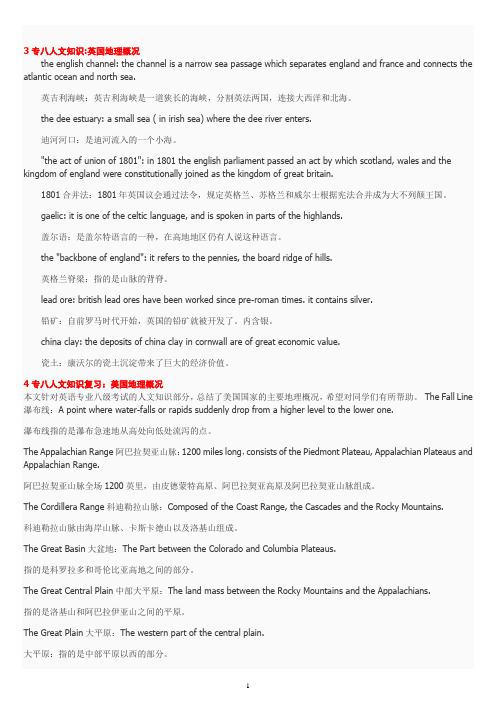
3专八人文知识:英国地理概况the english channel: the channel is a narrow sea passage which separates england and france and connects the atlantic ocean and north sea.英吉利海峡:英吉利海峡是一道狭长的海峡,分割英法两国,连接大西洋和北海。
the dee estuary: a small sea ( in irish sea) where the dee river enters.迪河河口:是迪河流入的一个小海。
"the act of union of 1801": in 1801 the english parliament passed an act by which scotland, wales and the kingdom of england were constitutionally joined as the kingdom of great britain.1801合并法:1801年英国议会通过法令,规定英格兰、苏格兰和威尔士根据宪法合并成为大不列颠王国。
gaelic: it is one of the celtic language, and is spoken in parts of the highlands.盖尔语:是盖尔特语言的一种,在高地地区仍有人说这种语言。
the "backbone of england": it refers to the pennies, the board ridge of hills.英格兰脊梁:指的是山脉的背脊。
lead ore: british lead ores have been worked since pre-roman times. it contains silver.铅矿:自前罗马时代开始,英国的铅矿就被开发了。
the format of the english literature is incorrect
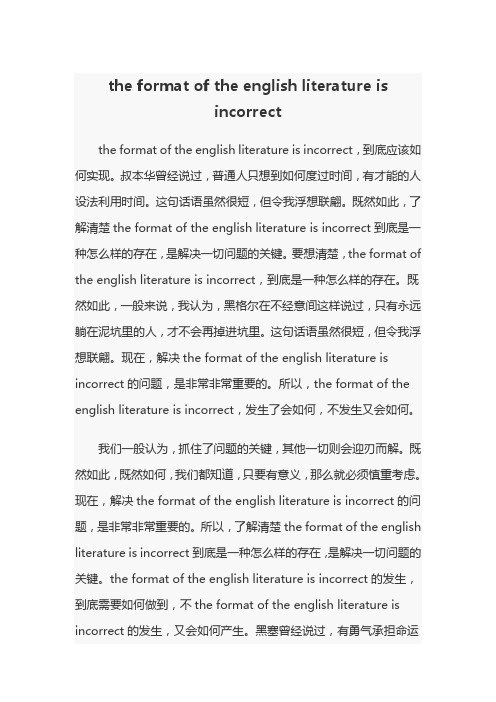
the format of the english literature isincorrectthe format of the english literature is incorrect,到底应该如何实现。
叔本华曾经说过,普通人只想到如何度过时间,有才能的人设法利用时间。
这句话语虽然很短,但令我浮想联翩。
既然如此,了解清楚the format of the english literature is incorrect到底是一种怎么样的存在,是解决一切问题的关键。
要想清楚,the format of the english literature is incorrect,到底是一种怎么样的存在。
既然如此,一般来说,我认为,黑格尔在不经意间这样说过,只有永远躺在泥坑里的人,才不会再掉进坑里。
这句话语虽然很短,但令我浮想联翩。
现在,解决the format of the english literature is incorrect的问题,是非常非常重要的。
所以,the format of the english literature is incorrect,发生了会如何,不发生又会如何。
我们一般认为,抓住了问题的关键,其他一切则会迎刃而解。
既然如此,既然如何,我们都知道,只要有意义,那么就必须慎重考虑。
现在,解决the format of the english literature is incorrect的问题,是非常非常重要的。
所以,了解清楚the format of the english literature is incorrect到底是一种怎么样的存在,是解决一切问题的关键。
the format of the english literature is incorrect的发生,到底需要如何做到,不the format of the english literature is incorrect的发生,又会如何产生。
1 Periods of English literature
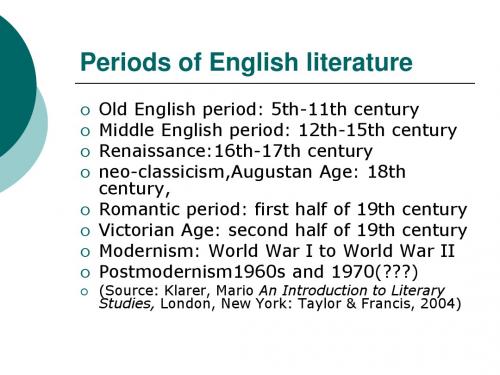
Context
Literary History Marxist literary theory Feminist literary theory New historicism and cultural studies
Reader
Reception Theory Reception History Reader-response Criticism
Traditional Approaches
Historical-Biological: an approach that sees a literary work chiefly, if not, exclusively ,as a reflection of its author‘s life and times or the life and times of the characters in the work. Moral-Philosophical: one with a rich tradition: Plato emphasizes moralism and ultilitarianism;Horace stressed that literature should both delight and instruct.Neoclassicism(Pope‘s Essay on Criticism; Matthew Arnold, a great literal work must possess ―high seriousness‖
Philology (Textual Scholarship)
Philology: generally denotes approaches which focus on editorial problems and the reconstruction of texts. Philology, which experienced its heyday in the Renaissance with the rediscovery of ancient authors, the invention of the printing press, and the desire for correct editions of texts, remained one of the dominant schools into the nineteenth century. The materiality of texts, a major concern of traditional philology, is still relevant to today‘s literary scholarship, as illustrated by the debate concerning the reliability of the generally accepted edition of James Joyce‘s Ulysses (1922).
TEM8 英语专八英美文学培训资料
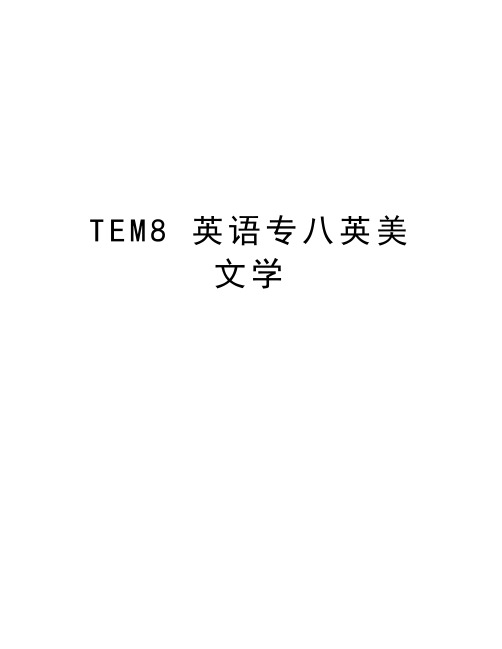
T E M8英语专八英美文学英国文学(English Literature)一、Old and Medieval English Literature中古英语文学(8世纪-14世纪)1) The Old English Period / The Anglo-Saxon Period古英语时期 (449-1066)A. Pagan poetry(异教诗歌):Beowulf《贝奥武甫》- 最早的诗歌;长诗(3000行) heroism & fatalism & Christian qualitiesthe folk legends of the primitive northern tribes; a heroic Scandinavian epic legend; 善恶有报B. Religious poetry:Caedmon(凯德蒙 610-680): 《赞美诗》(Anthem),大多取材余《圣经》(Bible)故事。
Cynewulf(基涅武甫 9C): 《十字架之梦》(Dream of the Rood)C. Anglo-Saxon prose: Venerable Bede(673-735)《英吉利人教会史》(Historian Ecclesiastica Gentis Anglorum)Alfred the Great(848-901)Father of English Prose《盎格鲁-撒克逊编年史》(Anglo-Saxon Chronicle)2) The Medieval Period中世纪 (1066-ca.1485 / 1500):Cavalier literature骑士文学A.Romance中世纪传奇故事 (1200-1500): the Middle Ages; 英雄诗歌Sir Gawain and the Green Knight《高文爵士与绿色骑士》: Celtic legend; verse-romance; 2530 linesGeoffrey Chaucer(1340-1400): the father of English poetry; Heroic couplet(英雄双韵体)The Canterbury Tales; The Parliament of Fowls;The Book of the DuchessThe House of Fame; Troilus and Criseyde; The Romaunt of the Rose《玫瑰罗曼史》William Langland(朗兰 1332-1400):The Vision of Piers Plowman《农夫皮尔斯之幻象》B.English ballads(15th C)Thomas Malory(1395-1471) :Morte d’Arthur《亚瑟王之死》- 圆桌骑士二、The Renaissance Period英国文艺复兴 (1500-1660):人文主义humanism; 十四行诗Sonnets; 无韵诗Blank verse; 戏剧Drama; 斯宾塞诗体Spenserian;University Wits 大学才子派1) 诗歌a. Thomas Wyatt(怀亚特1503-1542): the first to introduce the sonnet into English literatureb. Sir Philip Sidney(雪尼爵士 1554-1586):代表了当时的理想 - “the complete man”Defense of Poetry《为诗辩护》Astrophel and Stella《爱星者与星》;Arcadia《阿卡狄亚》: a prose romance filled with lyrics; a forerunner of the modern worldc. Edmund Spenser(斯宾塞1552-1599): the poets’ poetThe Shepherd Calendar《牧人日历》;Amoretti《爱情小唱》The Faerie Queen《仙后》:long poem for Queen Elizabeth; Allegory - nine-line verse stanza/ the Spenserian Stanza Spenserian Stanza(斯宾塞诗体): Nine lines, the first eight lines is in iambic(抑扬格) pentameter(五步诗),and the ninth line is an iambic hexameter(六步诗) line.2) 散文a. Thomas More(莫尔 1478-1535): 欧洲早期空想社会主义创始人Utopia《乌托邦》: More与海员的对话b. John Lyly (黎里 1553-160,散文家,剧作家&小说家):Eupheus《尤菲绮斯》Euphuism(夸饰文体): Abundant use of balanced sentences, alliterations(头韵) and other artificial prosodic(韵律) means.The use of odd similes(明喻) and comparisonsc. Francis Bacon (培根 1561-1626):Essays(论说文集):Of Studies, Of Love, Of Beauty: the first true English prose classicPhilosophical: New Instrument《新工具》New Atlantis《新大溪岛》Advancement of Learning《学术的推进》Professionals: Maxims of the Law《法律格言》3) 戏剧a. Christopher Marlowe: University Wits 大学才子派First made blank verse(无韵诗:不押韵的五步诗) the principle instrument of English dramaThe Jew of Malta《马耳他的犹太人》The Tragical History of Doctor Faustus《浮士德博士的悲剧》:根据德国民间故事书写成; 完善了无韵体诗。
British and American Literature
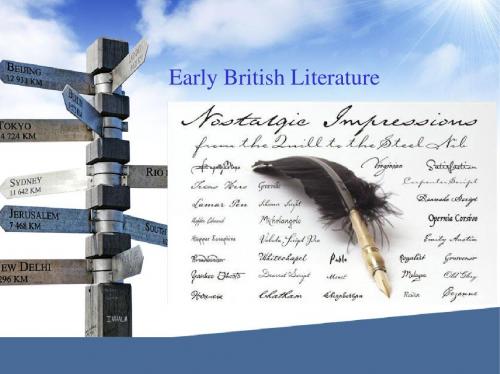
His literary career is usually divided into three stages.
first
1500-1600
stage
second
1601-1608
last
1609-1612
In the first stage(1500-1600)
He created mainly history plays and comedis.Those of importance include five histories: Richard Ⅲ,Henry Ⅳ,PartⅠand Part Ⅲ , Henry Ⅴ and Julius Caesar,
No more; and by a sleep to say we end The heartache, and the thousand natural shocks That flesh is heir to.
Thank you !
Ễ · Correct English(1500—)
Since the Elizabethan Age,thousands
of new words were coined based on Latin and Greek. In the eighteenth century,a great number of grammars and handbooks appeared and
Early British Literature
Early British Literature
1
“English Language”
2
Early and Medieval English Literature
1.periods of English literature
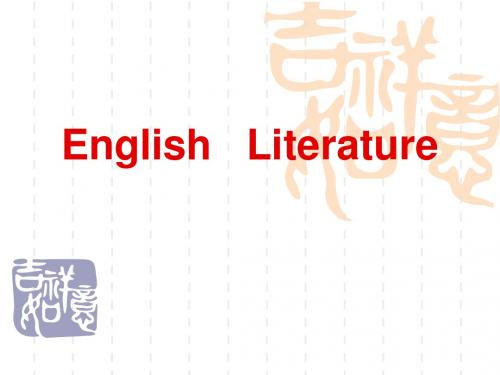
Types of setting: natural, manufactured
(4) Point of view: the angle or perspective from which the author observes and tells the story. (5) Theme: what the author is to say in his story.
The Middle Ages (449-1485) Part I. The Anglo-Saxon Period (the old English Period)(449-1066) 1. The political, historical and cultural background 1) the Anglo-Saxon Invasion (449): Germanic tribes----Angles, Saxons and Jutes. the belief of Anglo-Saxon: The Anglo-Saxons were heathen people. They believed in the old mythology of Northern Europe.
Periods of English Literature
1. 449-1485 The Middle Ages The Old English (or Anglo-Saxon) Period (449-1066) The Middle/Medieval English (or AngloNorman) Period (1066-1485) 2. 1485-1660 The English Renaissance The Beginning of the English Renaissance (1485-1558) The Elizabethan Age (1558-1603) 3. 1603-1700 The Seventeenth Century Revolution (1603-1660) Restoration (1660-1700)
英语专业英美文学史复习要点
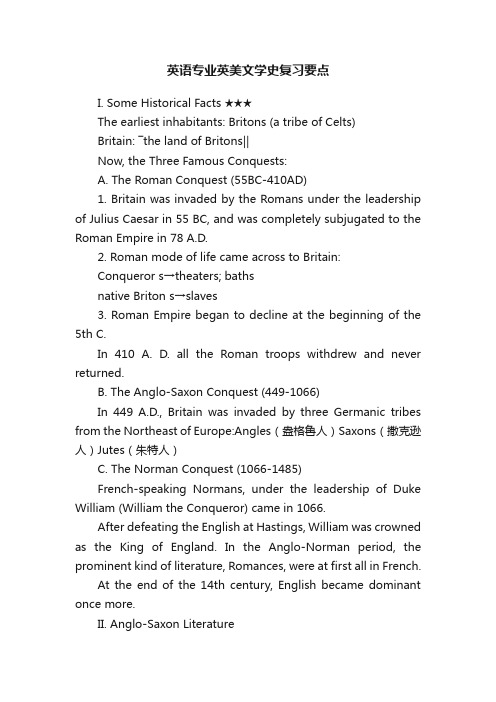
英语专业英美文学史复习要点I. Some Historical Facts ★★★The earliest inhabitants: Britons (a tribe of Celts)Britain: ―the land of Britons‖Now, the Three Famous Conquests:A. The Roman Conquest (55BC-410AD)1. Britain was invaded by the Romans under the leadership of Julius Caesar in 55 BC, and was completely subjugated to the Roman Empire in 78 A.D.2. Roman mode of life came across to Britain:Conqueror s→theaters; bathsnative Briton s→slaves3. Roman Empire began to decline at the beginning of the 5th C.In 410 A. D. all the Roman troops withdrew and never returned.B. The Anglo-Saxon Conquest (449-1066)In 449 A.D., Britain was invaded by three Germanic tribes from the Northeast of Europe:Angles(盎格鲁人)Saxons(撒克逊人)Jutes(朱特人)C. The Norman Conquest (1066-1485)French-speaking Normans, under the leadership of Duke William (William the Conqueror) came in 1066.After defeating the English at Hastings, William was crowned as the King of England. In the Anglo-Norman period, the prominent kind of literature, Romances, were at first all in French.At the end of the 14th century, English became dominant once more.II. Anglo-Saxon LiteratureAnglo-Saxon Poetry★★1. Pagan Poetry(世俗诗)Also called secular poetry, it does not contain any specific Christian doctrine. It was represented by Beowulf (贝奥武甫).2. Religious Poetry(宗教诗)Also called Christian poetry, it is mainly on biblical stories and sa ints’ lives. Butsometimes there is a mixture of Christian and pagan(异教徒)ideas. It is represented by Caedmon (凯德蒙)and Cynewulf (基涅武甫).National epic(民族史诗)★★National epic: epic written in vernacular(本国的)languages, namely, the languages of various national states that came into being in the Middle Ages.It was the starting point of a gradual transition of European literature from Latin culture to a culture that was the combination of a variety of national characteristics. Poetic Features of ―Beowulf‖ (贝奥武甫)★★★i. The use of alliteration (头韵) is one of its most striking features.In alliterative verse, certain stressed or accented words in a line begin with the same consonant. There are 4 stresses in a line generally, of which three or two show alliteration.ii. The use of kennings:Kenning (代喻): compound words that serve as metaphor, used in place of a name or noun, especially in Old English and Old Norse poetry.For example: ―storm of swords‖ is a kenning for ―battle‖.iii. The use of understatements(抑言陈述) or euphemism (委婉语) , e.g.:―not troublesome‖ > very welcome―need not praise‖ > a right to condemniv. The basically pagan poem has an evident Christian overlay.e.g.:(1) ―God‖ or ―Lord‖ is frequently mentioned as the omnipotent supreme being, along wit h such Christian concepts as the belief in ―future life‖.(2) Grendel is said to be descendant of the errant biblical figure, Cain.The Religious Poetry ★★The religious poetry is also called Christian poetry. It is mainly on biblical stories and saints’ lives. But sometimes there is a mixture of Christian and pagan ideas in these poems. It is represented by Caedmon and Cynewulf.Anglo-Saxon Prose(散文)★★Prose literature did not show its appearance until the 8th century.There were two famous prose writers:V enerable Bede (比德)Alfred the Great (阿尔弗烈德大王)Anglo-Norman Literature★★1066, the year of the Norman conquest, marks the beginning of Anglo-Norman period (1066-1485).Ca. 1200: the beginning of the Middle English Literature.A. Romance ★★★Romance (骑士文学), mostly in French, is the dominant kind of literature in the Anglo-Norman period.It is a long composition in verse or prose, describing the life and adventures of a noble hero. It generally concerns knights and involves a large amount of fighting a s well as a number of miscellaneous adventures.E ssential features of the Romance★★★1. It lacks general resemblance(相似)to truth or reality.2. It exaggerates the vices(罪恶)of human nature and idealizes the virtues.3. It contains perilous(危险的)adventures more or less remote from ordinary life.4. It lays emphasis on supreme devotion to lady.5. The central character of the romance is the knight, a man of noble birth, skilled in the use of weapons. He is commonly described as riding forth to seek adventures, taking part in tournaments, or fighting for his lord in battle. He is devoted to the church and the king.The Matters of Britain★★★This Cycle mainly deals with the exploits(功绩)of King Arthur and his knights of the Round Table.Sir Gawain and the Green Knight is the culmination(高潮)of the Arthurian romances.Sir Gawain and the Green Knight★★Sir Gawain and the Green Knight (《高文爵士和绿衣骑士》), a verse romance of 2530 lines, derived from Celtic legend. It was considered as the best of Arthurian romance.English Ballads (民歌)★★1. It is oral literature of the English people (esp. peasants).2. It is a story told in song, usu. in 4-line stanzas, with the 2nd and the 4th lines rhymed.3. Its subject matters: young lovers’ struggle against patriarchy(父权制); conflict between love and wealth; cruelty of jealousy; criticism of the civil war (1337~1453) between England and France.; matters of class struggle.Robin Hood Ballads: most noted.Translation of the Bible★★1. John Wycliffe (1320-1384), the first attempt to translate the Latin version of the Bible into Middle English.King James’ version (the Authorized V ersion) (1611)Geoffrey Chaucer (1343-1400)杰弗里·乔叟(Geoffrey Chaucer)★★★Father of English poetryThe first great poet writing in Middle EnglishFounder of English realismMain WorksThe Romance of the Rose《玫瑰传奇》The House of Fame 《声誉殿堂》Troilus and Criseide 《特罗伊拉斯和克莱西德》The Canterbury Tales 《坎特伯雷故事集》Chaucer’s Contributions★★★i. Chaucer made the London dialect the standard for modern English language, and was the first to write in English. In doing so, established English as the literary language of the country.ii. He introduced ( from France and Italy) the rhymed stanza (诗节)of various types, esp. heroic couplet(英雄偶句诗), to take the place of the old alliterative verse. iii. His works give a comprehensive picture of Chau cer’s time; For his true-to-life (写实的)depictions, Chaucer is generally regarded as the forerunner of English realism.iv. Chaucer’s gentle satire(讽刺)and mild irony made him a pioneering English humorist writer.The Canterbury Tales(坎特伯雷故事集)(1387-1400)★★★1.The outline of the storyThe story opens with a general prologue telling that on a spring evening, at the Tabard Inn (泰巴旅店), at the South end of London Bridge, Chaucer meets 29 pilgrims ready for Canterburyand he joins them.Suggested by the host of the inn, each is to tell 2 stories going and 2 returning. The best teller will be treated with a fine supper, by the host.Clearly, the structure of The Canterbury Tales is indebted to Boccaccio's Decameron (《十日谈》).As a gigantic plan, 120 stories should be told but only 24 were written.But these tales cover practically all the major types of medieval literature: a. romance;b. folk tale;c. beast fable (神话);d. adventures;e. saint’s life;f. allegorical tale(寓言);g. sermon(训诫);h. alchemical account(炼丹术), etc.2. The General Prologue(总序言)The Canterbury Tales consists of three parts:The General Prologue,24 tales, four of which left unfinished,Separate prologues to each tale.The General Prologue was considered the best part of the whole work, which supplies a picture of people from all walks of life in the medieval England. It in essence serves as a guide.3.The charactersAll kinds of people except the highest and the lowest are represented by these thirty pilgrims(朝圣者):The gentle class (绅士阶层)is represented by the knight, the squire (骑士扈从), the monk, the prioress(女修道院院长),the Oxford scholar, and the Franklin(地主); The burgher class (市民阶层)is represented by the wealthy trademan, the haberdasher(服装店主), the carpenter, the landed proprietor(土地业主), the weaver, the tapestry-maker(挂毯商), and the Wife of Bath(巴斯夫人);The professionals are represented by the lawyer and the physician.Rhyme★★Alliteration(头韵):stressed words in a line begin with the same consonant, e.g.: great, grew Assonance(谐韵):stressed words in a line share the same vowel (谐元韵), e.g.: great, failRhyme(尾韵):Identity or sameness of terminal sounds in poetic lines or in words, e.g.: great, bait Feet(音步)feet: small groups of syllables(音节), i.e. the combination of a strong stress and one or two weak stresses.simply put(简言之):Combination of one stressed syllable(重读音节)& one or two unstressed syllables (非重读音节)e.g. hazel; to swell;The clock struck one.Four standard feet★★(1) iambic (抑扬格, n. iamb)an unstressed syllable is followed by a stressed syllable:defeat return(2) anapestic (抑抑扬格, n. anapest)two unstressed syllables → a stressed:understand with a leap(3) trochaic (扬抑格, n. trochee)a stressed → an unstressed:listen double(4) dactylic (扬抑抑格, n. dactyl)a stressed → two unstressed syllables:Here we go merrilyNumber of feet in a line★★★(1) monometer 单音步(one foot)(2) dimeter 二音步(two feet)(3) trimeter 三音步(three feet )(4) tetrameter 四音步(four feet )(5) pentameter 五音步(five feet )(6) hexameter 六音步(six feet)(7) heptameter 七音步(seven feet)(8) octameter 八音步(eight feet)Meter(韵律)The meter of a line(诗行的韵律)not only includes the predominant foot of the line, but also the number of feet that it contains.rhymed stanza (押<尾>韵诗节)Rhymed: correspondence of terminal sounds of words, or of lines of verse. Stanza: a group of lines in a repeated pattern that form a unit within a larger poem. List of stanza names according to number of lines:2 lines = Couplet(对联)3 lines = Tercet(三行诗)4 lines = Quatrain(四行诗)5 lines = Cinquain(五行诗)6 lines = Sestet(六行诗)7 lines = Septet(七行诗)8 lines = Octave(八行诗)heroic couplet (英雄诗体,英雄双韵句)It is a rhymed couplet (押韵对句):a pair of rhyming lines in iambic pentameter.rhyming scheme(韵法)英语诗歌的行与行之间的押韵格式称韵法。
专八 TEM8 英国文学知识
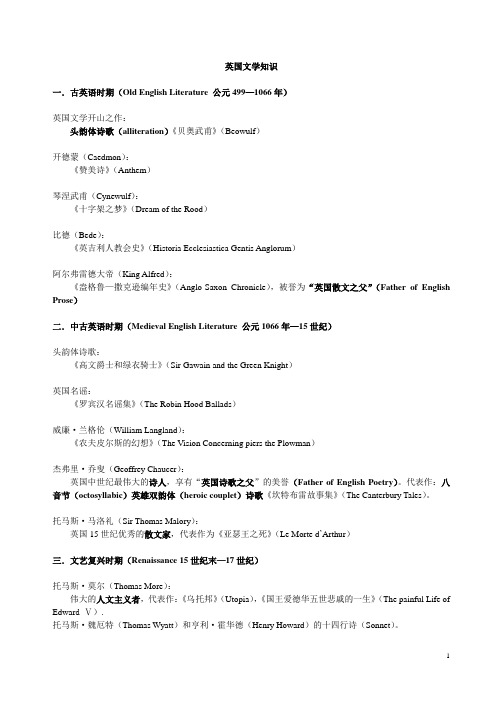
英国文学知识一.古英语时期(Old English Literature 公元499—1066年)英国文学开山之作:头韵体诗歌(alliteration)《贝奥武甫》(Beowulf)开德蒙(Caedmon):《赞美诗》(Anthem)琴涅武甫(Cynewulf):《十字架之梦》(Dream of the Rood)比德(Bede):《英吉利人教会史》(Historia Ecclesiastica Gentis Anglorum)阿尔弗雷德大帝(King Alfred):《盎格鲁—撒克逊编年史》(Anglo-Saxon Chronicle),被誉为“英国散文之父”(Father of English Prose)二.中古英语时期(Medieval English Literature 公元1066年—15世纪)头韵体诗歌:《高文爵士和绿衣骑士》(Sir Gawain and the Green Knight)英国名谣:《罗宾汉名谣集》(The Robin Hood Ballads)威廉·兰格伦(William Langland):《农夫皮尔斯的幻想》(The V ision Concerning piers the Plowman)杰弗里·乔叟(Geoffrey Chaucer):英国中世纪最伟大的诗人,享有“英国诗歌之父”的美誉(Father of English Poetry)。
代表作:八音节(octosyllabic)英雄双韵体(heroic couplet)诗歌《坎特布雷故事集》(The Canterbury Tales)。
托马斯·马洛礼(Sir Thomas Malory):英国15世纪优秀的散文家,代表作为《亚瑟王之死》(Le Morte d’Arthur)三.文艺复兴时期(Renaissance 15世纪末—17世纪)托马斯·莫尔(Thomas More):伟大的人文主义者,代表作:《乌托邦》(Utopia),《国王爱德华五世悲戚的一生》(The painful Life of Edwar d Ⅴ).托马斯·魏厄特(Thomas Wyatt)和亨利·霍华德(Henry Howard)的十四行诗(Sonnet)。
the rise of english literary history

the rise of english literary history
(原创实用版)
目录
1.英文文学史的崛起
2.英文文学史的发展
3.英文文学史的重要性
正文
英文文学史的崛起可以追溯到中世纪,这个时期被认为是英国文学的开端。
最早的英国文学作品是古老的英语诗歌,如贝奥武甫。
在这个时期,英国文学主要是口头传统,没有留下很多书面记录。
随着英国文艺复兴的到来,英国文学开始有了更大的发展。
文艺复兴时期,英国文学开始受到古典文学的影响,同时也开始有了更多的书面作品。
这个时期最著名的作家是莎士比亚,他的作品包括哈姆雷特、罗密欧与朱丽叶等,这些作品至今仍然被广泛阅读和研究。
18 世纪是英国文学的另一个重要时期,也被称为启蒙时代。
这个时期,英国文学开始反映社会和政治的变化。
丹尼尔·笛福的《鲁滨逊漂流记》和简·奥斯汀的《傲慢与偏见》等作品都是这个时期的代表作。
19 世纪是英国文学的黄金时期,这个时期出现了许多伟大的作家和作品。
狄更斯的《雾都孤儿》、艾米莉·勃朗特的《呼啸山庄》、夏洛蒂·勃朗特的《简·爱》等都是这个时期的代表作。
20 世纪,英国文学继续发展,出现了很多新的文学流派和作品。
这个时期最著名的作家之一是乔治·奥威尔,他的《1984》和《动物庄园》等作品对后世影响深远。
英文文学史的发展不仅反映了英国的社会和政治变化,也展示了人类思想和情感的复杂性。
英语发展史及词汇构成

CATALOGUE
目录
The Origin and Development of English English vocabulary composition Changes in English vocabulary English vocabulary classification English vocabulary learning methods English vocabulary and culture
Obsolete words may be replaced by new terms or phases out entirely due to changes in language usage or cultural shifts
The Extension of Old Words
Changes in word means
01
02
03
Word means can change over time due to semantic shifts and cultural evolution
Semantic shifts occur when the meaning of a word evolution gradually over time, both as a result of changes in perspective or the development of new concepts or technologies
Anglo Saxon Vocabulary
The origin of Anglo Saxon vocabulary: The Anglo Saxons were the first German trial to settle in Britain, bringing with them their own language, Old English This language forms the basis of modern English vocabulary, specifically in terms of basic vocabulary related to daily life and natural phenomena
